LLN Evaluation Form
VerifiedAdded on 2022/12/26
|29
|4802
|1
AI Summary
The LLN Evaluation Form is used to assess the Language, Literacy, and Numeracy (LLN) skills of employees. It evaluates reading, writing, oral, and numeracy skills based on the Australian Core Skills Framework (ACSF). The form includes tasks and examples for each skill level, ranging from basic to advanced. It also provides comments and feedback for improvement. This form is developed from information contained in the ACSF by Compliant Learning Resources.
Contribute Materials
Your contribution can guide someone’s learning journey. Share your
documents today.
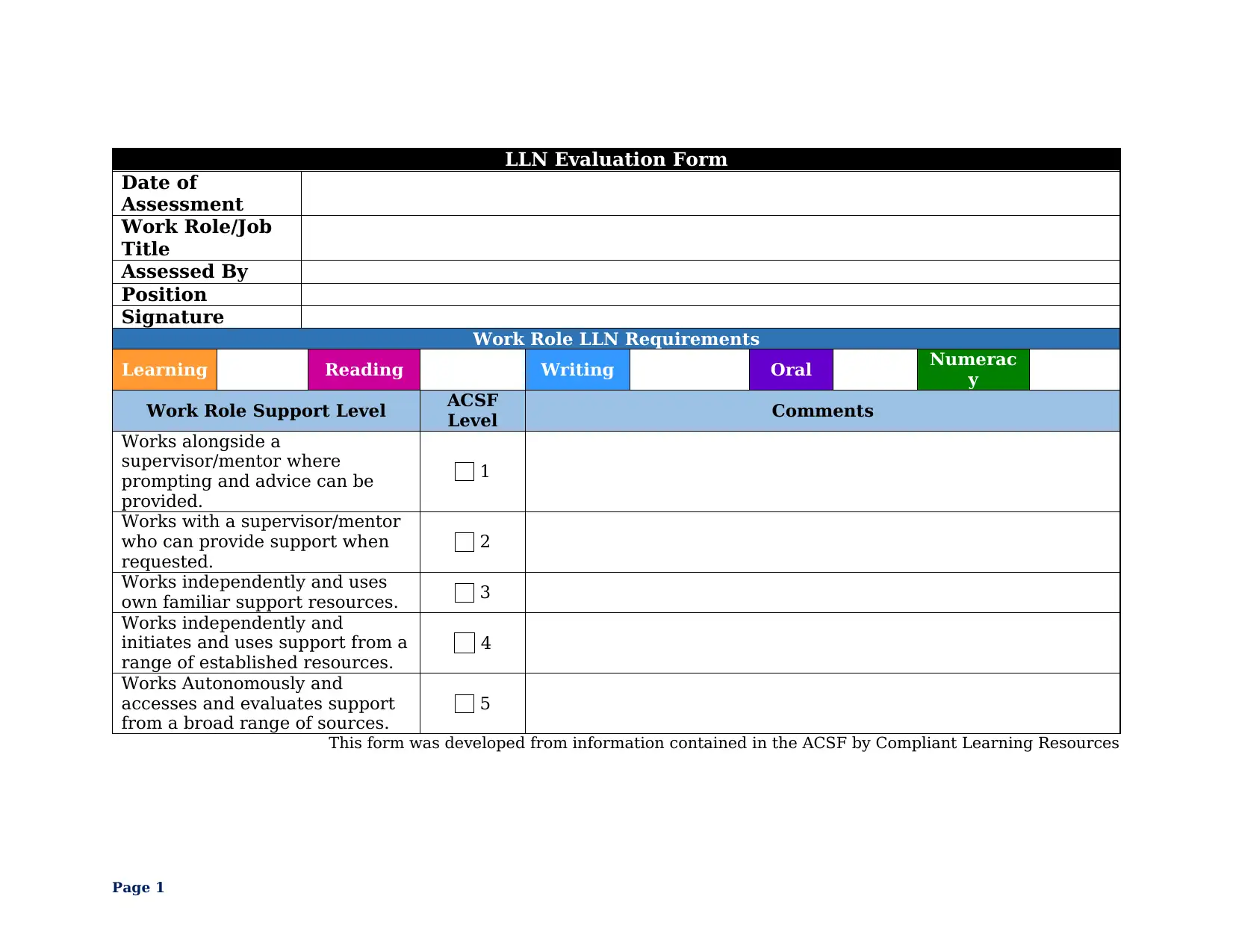
LLN Evaluation Form
Date of
Assessment
Work Role/Job
Title
Assessed By
Position
Signature
Work Role LLN Requirements
Learning Reading Writing Oral Numerac
y
Work Role Support Level ACSF
Level Comments
Works alongside a
supervisor/mentor where
prompting and advice can be
provided.
1
Works with a supervisor/mentor
who can provide support when
requested.
2
Works independently and uses
own familiar support resources. 3
Works independently and
initiates and uses support from a
range of established resources.
4
Works Autonomously and
accesses and evaluates support
from a broad range of sources.
5
This form was developed from information contained in the ACSF by Compliant Learning Resources
Page 1
Date of
Assessment
Work Role/Job
Title
Assessed By
Position
Signature
Work Role LLN Requirements
Learning Reading Writing Oral Numerac
y
Work Role Support Level ACSF
Level Comments
Works alongside a
supervisor/mentor where
prompting and advice can be
provided.
1
Works with a supervisor/mentor
who can provide support when
requested.
2
Works independently and uses
own familiar support resources. 3
Works independently and
initiates and uses support from a
range of established resources.
4
Works Autonomously and
accesses and evaluates support
from a broad range of sources.
5
This form was developed from information contained in the ACSF by Compliant Learning Resources
Page 1
Secure Best Marks with AI Grader
Need help grading? Try our AI Grader for instant feedback on your assignments.
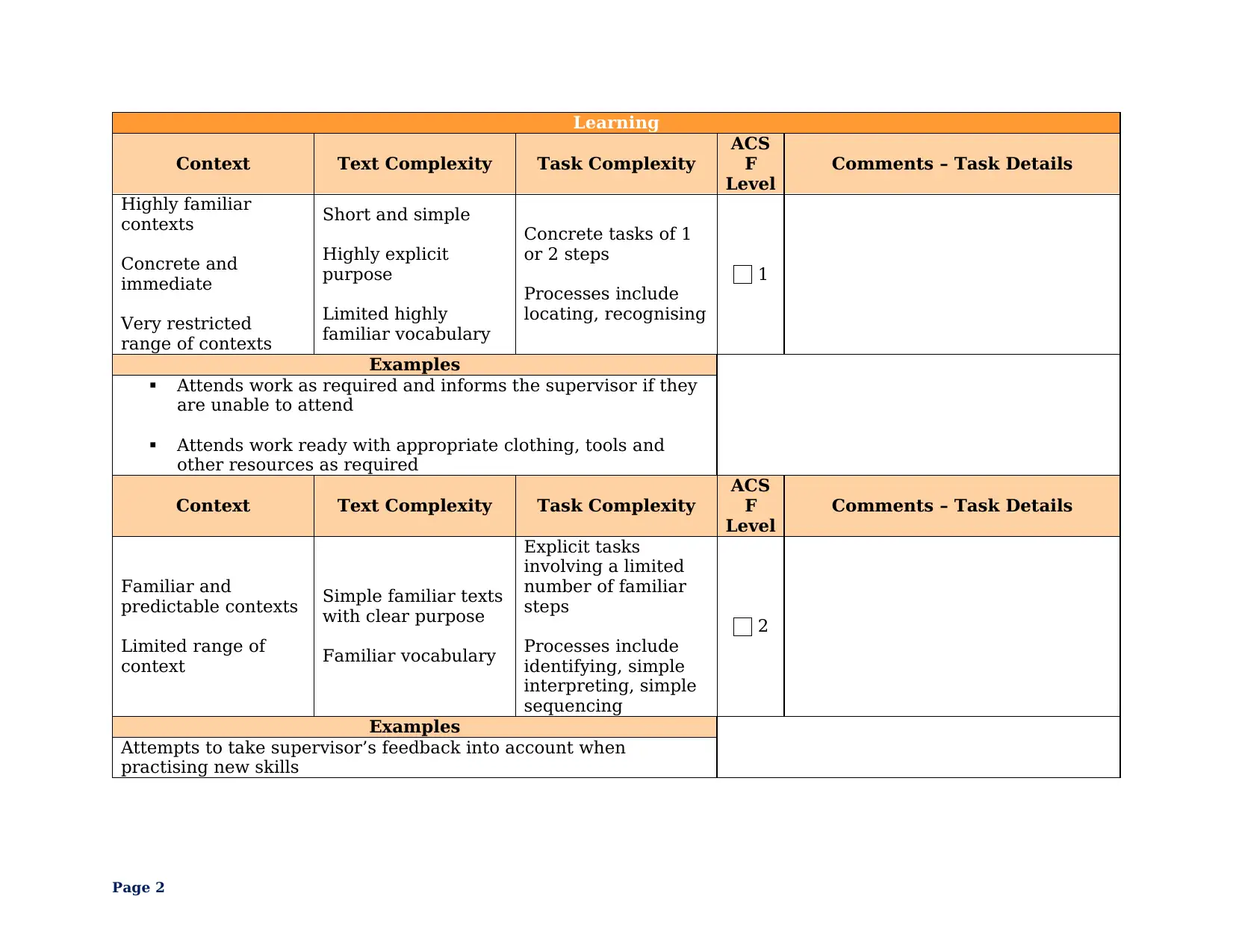
Learning
Context Text Complexity Task Complexity
ACS
F
Level
Comments – Task Details
Highly familiar
contexts
Concrete and
immediate
Very restricted
range of contexts
Short and simple
Highly explicit
purpose
Limited highly
familiar vocabulary
Concrete tasks of 1
or 2 steps
Processes include
locating, recognising
1
Examples
Attends work as required and informs the supervisor if they
are unable to attend
Attends work ready with appropriate clothing, tools and
other resources as required
Context Text Complexity Task Complexity
ACS
F
Level
Comments – Task Details
Familiar and
predictable contexts
Limited range of
context
Simple familiar texts
with clear purpose
Familiar vocabulary
Explicit tasks
involving a limited
number of familiar
steps
Processes include
identifying, simple
interpreting, simple
sequencing
2
Examples
Attempts to take supervisor’s feedback into account when
practising new skills
Page 2
Context Text Complexity Task Complexity
ACS
F
Level
Comments – Task Details
Highly familiar
contexts
Concrete and
immediate
Very restricted
range of contexts
Short and simple
Highly explicit
purpose
Limited highly
familiar vocabulary
Concrete tasks of 1
or 2 steps
Processes include
locating, recognising
1
Examples
Attends work as required and informs the supervisor if they
are unable to attend
Attends work ready with appropriate clothing, tools and
other resources as required
Context Text Complexity Task Complexity
ACS
F
Level
Comments – Task Details
Familiar and
predictable contexts
Limited range of
context
Simple familiar texts
with clear purpose
Familiar vocabulary
Explicit tasks
involving a limited
number of familiar
steps
Processes include
identifying, simple
interpreting, simple
sequencing
2
Examples
Attempts to take supervisor’s feedback into account when
practising new skills
Page 2
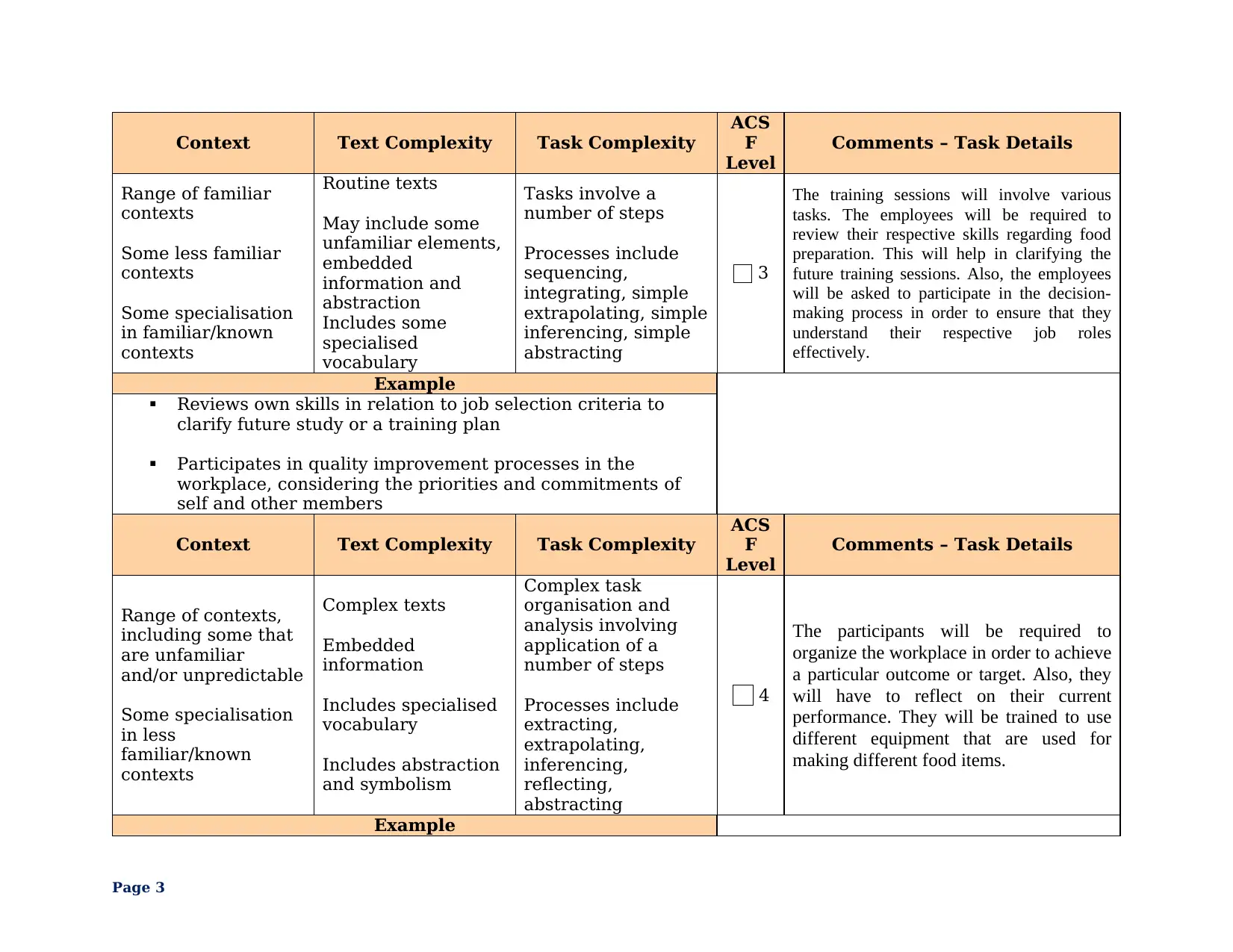
Context Text Complexity Task Complexity
ACS
F
Level
Comments – Task Details
Range of familiar
contexts
Some less familiar
contexts
Some specialisation
in familiar/known
contexts
Routine texts
May include some
unfamiliar elements,
embedded
information and
abstraction
Includes some
specialised
vocabulary
Tasks involve a
number of steps
Processes include
sequencing,
integrating, simple
extrapolating, simple
inferencing, simple
abstracting
3
The training sessions will involve various
tasks. The employees will be required to
review their respective skills regarding food
preparation. This will help in clarifying the
future training sessions. Also, the employees
will be asked to participate in the decision-
making process in order to ensure that they
understand their respective job roles
effectively.
Example
Reviews own skills in relation to job selection criteria to
clarify future study or a training plan
Participates in quality improvement processes in the
workplace, considering the priorities and commitments of
self and other members
Context Text Complexity Task Complexity
ACS
F
Level
Comments – Task Details
Range of contexts,
including some that
are unfamiliar
and/or unpredictable
Some specialisation
in less
familiar/known
contexts
Complex texts
Embedded
information
Includes specialised
vocabulary
Includes abstraction
and symbolism
Complex task
organisation and
analysis involving
application of a
number of steps
Processes include
extracting,
extrapolating,
inferencing,
reflecting,
abstracting
4
The participants will be required to
organize the workplace in order to achieve
a particular outcome or target. Also, they
will have to reflect on their current
performance. They will be trained to use
different equipment that are used for
making different food items.
Example
Page 3
ACS
F
Level
Comments – Task Details
Range of familiar
contexts
Some less familiar
contexts
Some specialisation
in familiar/known
contexts
Routine texts
May include some
unfamiliar elements,
embedded
information and
abstraction
Includes some
specialised
vocabulary
Tasks involve a
number of steps
Processes include
sequencing,
integrating, simple
extrapolating, simple
inferencing, simple
abstracting
3
The training sessions will involve various
tasks. The employees will be required to
review their respective skills regarding food
preparation. This will help in clarifying the
future training sessions. Also, the employees
will be asked to participate in the decision-
making process in order to ensure that they
understand their respective job roles
effectively.
Example
Reviews own skills in relation to job selection criteria to
clarify future study or a training plan
Participates in quality improvement processes in the
workplace, considering the priorities and commitments of
self and other members
Context Text Complexity Task Complexity
ACS
F
Level
Comments – Task Details
Range of contexts,
including some that
are unfamiliar
and/or unpredictable
Some specialisation
in less
familiar/known
contexts
Complex texts
Embedded
information
Includes specialised
vocabulary
Includes abstraction
and symbolism
Complex task
organisation and
analysis involving
application of a
number of steps
Processes include
extracting,
extrapolating,
inferencing,
reflecting,
abstracting
4
The participants will be required to
organize the workplace in order to achieve
a particular outcome or target. Also, they
will have to reflect on their current
performance. They will be trained to use
different equipment that are used for
making different food items.
Example
Page 3
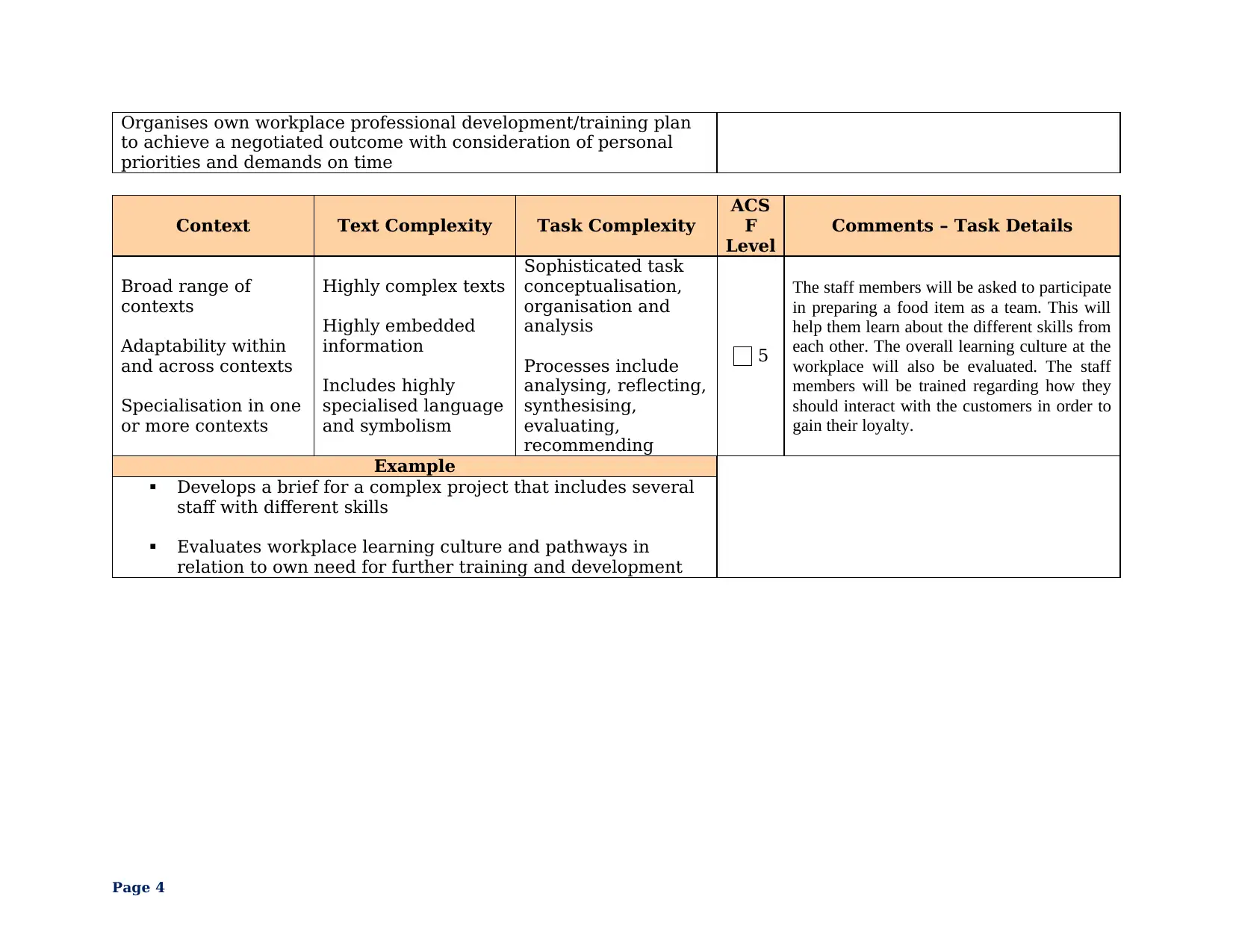
Organises own workplace professional development/training plan
to achieve a negotiated outcome with consideration of personal
priorities and demands on time
Context Text Complexity Task Complexity
ACS
F
Level
Comments – Task Details
Broad range of
contexts
Adaptability within
and across contexts
Specialisation in one
or more contexts
Highly complex texts
Highly embedded
information
Includes highly
specialised language
and symbolism
Sophisticated task
conceptualisation,
organisation and
analysis
Processes include
analysing, reflecting,
synthesising,
evaluating,
recommending
5
The staff members will be asked to participate
in preparing a food item as a team. This will
help them learn about the different skills from
each other. The overall learning culture at the
workplace will also be evaluated. The staff
members will be trained regarding how they
should interact with the customers in order to
gain their loyalty.
Example
Develops a brief for a complex project that includes several
staff with different skills
Evaluates workplace learning culture and pathways in
relation to own need for further training and development
Page 4
to achieve a negotiated outcome with consideration of personal
priorities and demands on time
Context Text Complexity Task Complexity
ACS
F
Level
Comments – Task Details
Broad range of
contexts
Adaptability within
and across contexts
Specialisation in one
or more contexts
Highly complex texts
Highly embedded
information
Includes highly
specialised language
and symbolism
Sophisticated task
conceptualisation,
organisation and
analysis
Processes include
analysing, reflecting,
synthesising,
evaluating,
recommending
5
The staff members will be asked to participate
in preparing a food item as a team. This will
help them learn about the different skills from
each other. The overall learning culture at the
workplace will also be evaluated. The staff
members will be trained regarding how they
should interact with the customers in order to
gain their loyalty.
Example
Develops a brief for a complex project that includes several
staff with different skills
Evaluates workplace learning culture and pathways in
relation to own need for further training and development
Page 4
Secure Best Marks with AI Grader
Need help grading? Try our AI Grader for instant feedback on your assignments.
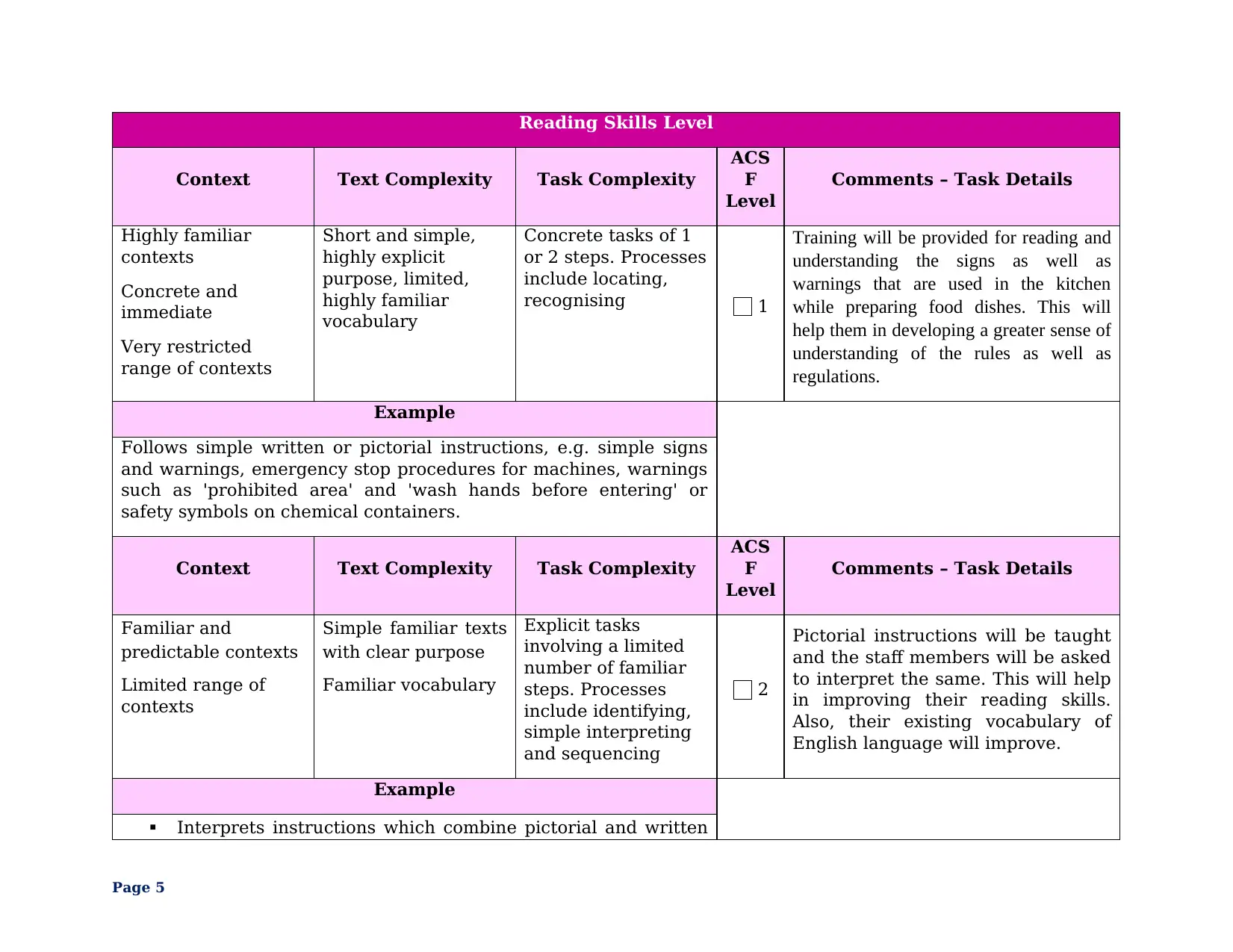
Reading Skills Level
Context Text Complexity Task Complexity
ACS
F
Level
Comments – Task Details
Highly familiar
contexts
Concrete and
immediate
Very restricted
range of contexts
Short and simple,
highly explicit
purpose, limited,
highly familiar
vocabulary
Concrete tasks of 1
or 2 steps. Processes
include locating,
recognising 1
Training will be provided for reading and
understanding the signs as well as
warnings that are used in the kitchen
while preparing food dishes. This will
help them in developing a greater sense of
understanding of the rules as well as
regulations.
Example
Follows simple written or pictorial instructions, e.g. simple signs
and warnings, emergency stop procedures for machines, warnings
such as 'prohibited area' and 'wash hands before entering' or
safety symbols on chemical containers.
Context Text Complexity Task Complexity
ACS
F
Level
Comments – Task Details
Familiar and
predictable contexts
Limited range of
contexts
Simple familiar texts
with clear purpose
Familiar vocabulary
Explicit tasks
involving a limited
number of familiar
steps. Processes
include identifying,
simple interpreting
and sequencing
2
Pictorial instructions will be taught
and the staff members will be asked
to interpret the same. This will help
in improving their reading skills.
Also, their existing vocabulary of
English language will improve.
Example
Interprets instructions which combine pictorial and written
Page 5
Context Text Complexity Task Complexity
ACS
F
Level
Comments – Task Details
Highly familiar
contexts
Concrete and
immediate
Very restricted
range of contexts
Short and simple,
highly explicit
purpose, limited,
highly familiar
vocabulary
Concrete tasks of 1
or 2 steps. Processes
include locating,
recognising 1
Training will be provided for reading and
understanding the signs as well as
warnings that are used in the kitchen
while preparing food dishes. This will
help them in developing a greater sense of
understanding of the rules as well as
regulations.
Example
Follows simple written or pictorial instructions, e.g. simple signs
and warnings, emergency stop procedures for machines, warnings
such as 'prohibited area' and 'wash hands before entering' or
safety symbols on chemical containers.
Context Text Complexity Task Complexity
ACS
F
Level
Comments – Task Details
Familiar and
predictable contexts
Limited range of
contexts
Simple familiar texts
with clear purpose
Familiar vocabulary
Explicit tasks
involving a limited
number of familiar
steps. Processes
include identifying,
simple interpreting
and sequencing
2
Pictorial instructions will be taught
and the staff members will be asked
to interpret the same. This will help
in improving their reading skills.
Also, their existing vocabulary of
English language will improve.
Example
Interprets instructions which combine pictorial and written
Page 5
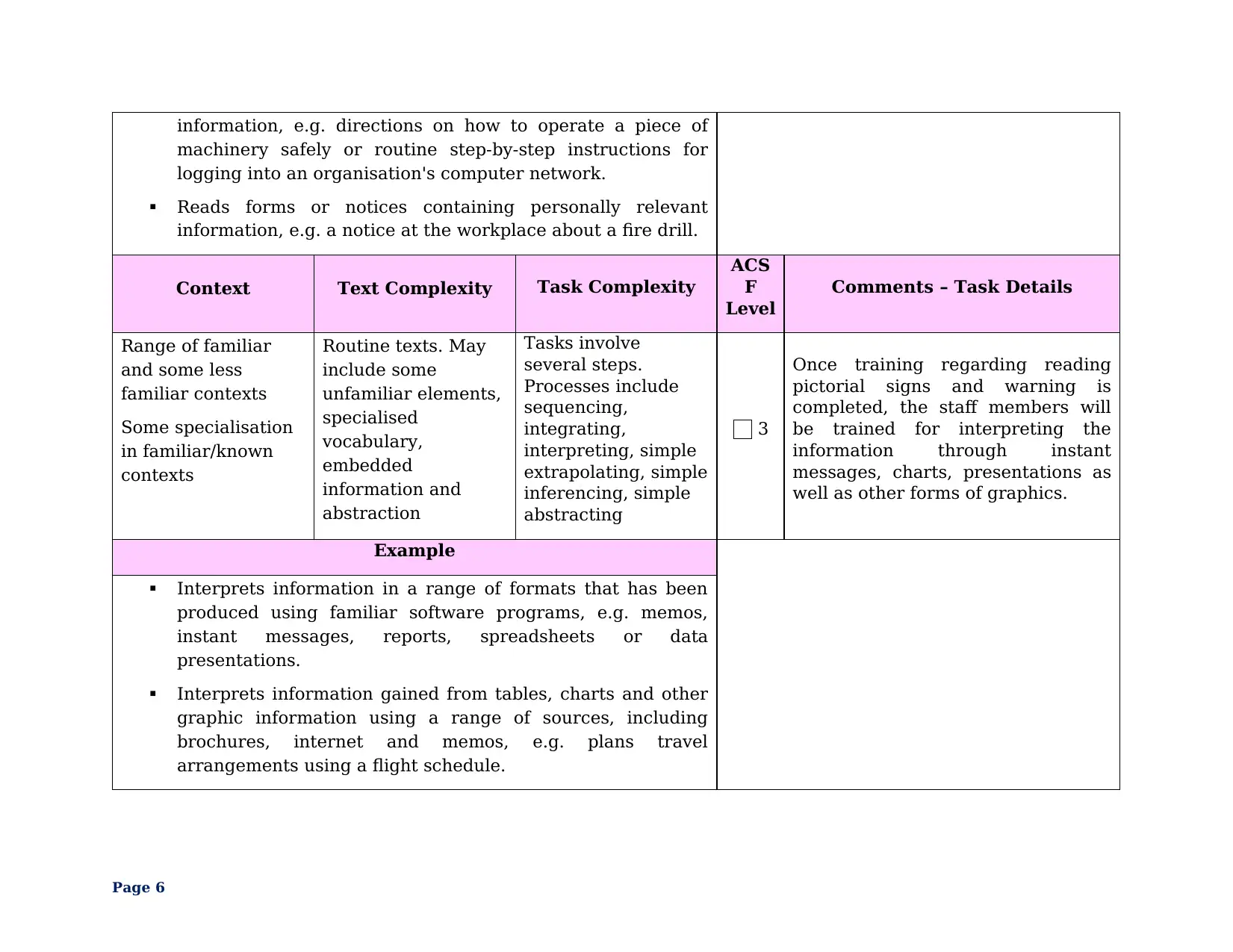
information, e.g. directions on how to operate a piece of
machinery safely or routine step-by-step instructions for
logging into an organisation's computer network.
Reads forms or notices containing personally relevant
information, e.g. a notice at the workplace about a fire drill.
Context Text Complexity Task Complexity
ACS
F
Level
Comments – Task Details
Range of familiar
and some less
familiar contexts
Some specialisation
in familiar/known
contexts
Routine texts. May
include some
unfamiliar elements,
specialised
vocabulary,
embedded
information and
abstraction
Tasks involve
several steps.
Processes include
sequencing,
integrating,
interpreting, simple
extrapolating, simple
inferencing, simple
abstracting
3
Once training regarding reading
pictorial signs and warning is
completed, the staff members will
be trained for interpreting the
information through instant
messages, charts, presentations as
well as other forms of graphics.
Example
Interprets information in a range of formats that has been
produced using familiar software programs, e.g. memos,
instant messages, reports, spreadsheets or data
presentations.
Interprets information gained from tables, charts and other
graphic information using a range of sources, including
brochures, internet and memos, e.g. plans travel
arrangements using a flight schedule.
Page 6
machinery safely or routine step-by-step instructions for
logging into an organisation's computer network.
Reads forms or notices containing personally relevant
information, e.g. a notice at the workplace about a fire drill.
Context Text Complexity Task Complexity
ACS
F
Level
Comments – Task Details
Range of familiar
and some less
familiar contexts
Some specialisation
in familiar/known
contexts
Routine texts. May
include some
unfamiliar elements,
specialised
vocabulary,
embedded
information and
abstraction
Tasks involve
several steps.
Processes include
sequencing,
integrating,
interpreting, simple
extrapolating, simple
inferencing, simple
abstracting
3
Once training regarding reading
pictorial signs and warning is
completed, the staff members will
be trained for interpreting the
information through instant
messages, charts, presentations as
well as other forms of graphics.
Example
Interprets information in a range of formats that has been
produced using familiar software programs, e.g. memos,
instant messages, reports, spreadsheets or data
presentations.
Interprets information gained from tables, charts and other
graphic information using a range of sources, including
brochures, internet and memos, e.g. plans travel
arrangements using a flight schedule.
Page 6
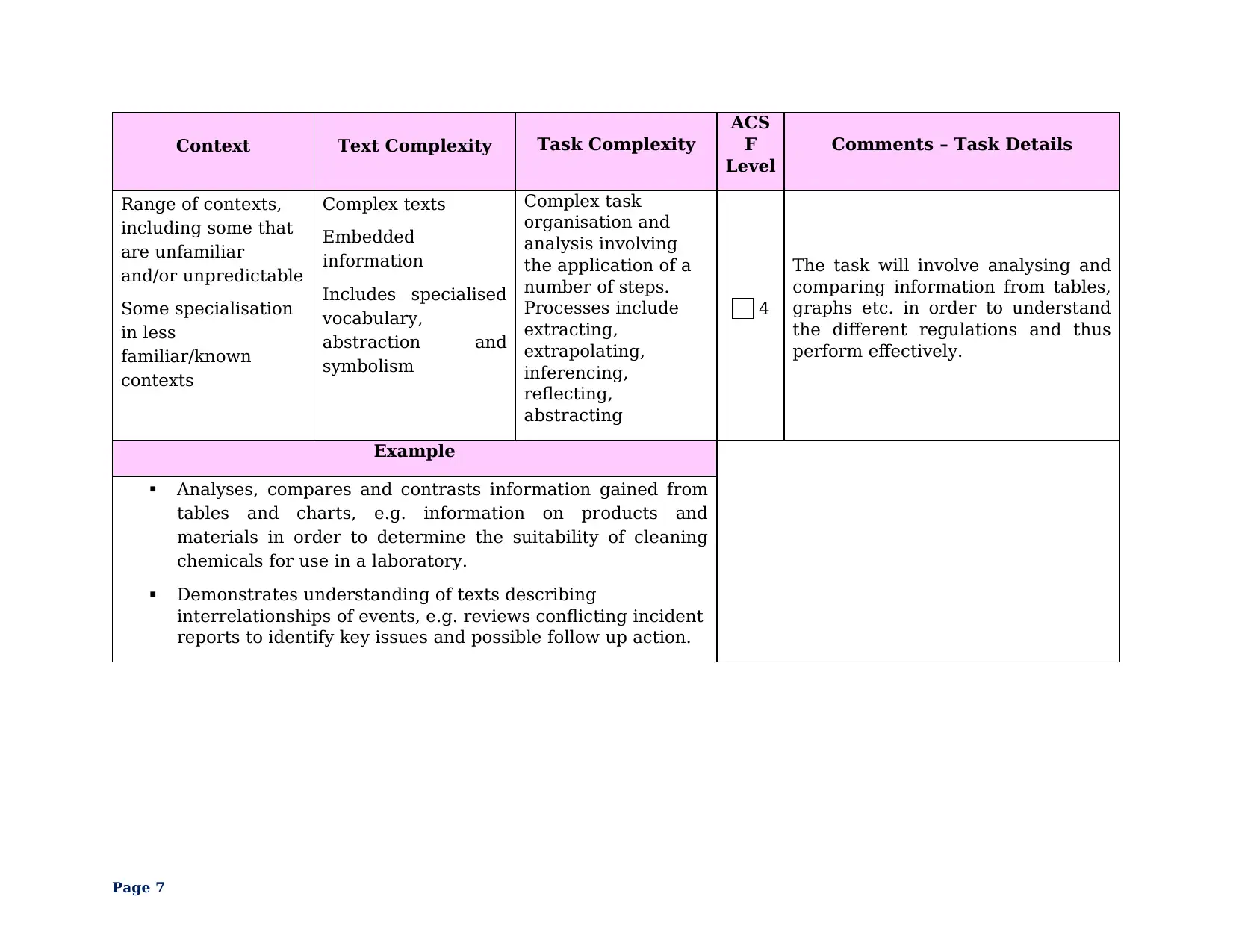
Context Text Complexity Task Complexity
ACS
F
Level
Comments – Task Details
Range of contexts,
including some that
are unfamiliar
and/or unpredictable
Some specialisation
in less
familiar/known
contexts
Complex texts
Embedded
information
Includes specialised
vocabulary,
abstraction and
symbolism
Complex task
organisation and
analysis involving
the application of a
number of steps.
Processes include
extracting,
extrapolating,
inferencing,
reflecting,
abstracting
4
The task will involve analysing and
comparing information from tables,
graphs etc. in order to understand
the different regulations and thus
perform effectively.
Example
Analyses, compares and contrasts information gained from
tables and charts, e.g. information on products and
materials in order to determine the suitability of cleaning
chemicals for use in a laboratory.
Demonstrates understanding of texts describing
interrelationships of events, e.g. reviews conflicting incident
reports to identify key issues and possible follow up action.
Page 7
ACS
F
Level
Comments – Task Details
Range of contexts,
including some that
are unfamiliar
and/or unpredictable
Some specialisation
in less
familiar/known
contexts
Complex texts
Embedded
information
Includes specialised
vocabulary,
abstraction and
symbolism
Complex task
organisation and
analysis involving
the application of a
number of steps.
Processes include
extracting,
extrapolating,
inferencing,
reflecting,
abstracting
4
The task will involve analysing and
comparing information from tables,
graphs etc. in order to understand
the different regulations and thus
perform effectively.
Example
Analyses, compares and contrasts information gained from
tables and charts, e.g. information on products and
materials in order to determine the suitability of cleaning
chemicals for use in a laboratory.
Demonstrates understanding of texts describing
interrelationships of events, e.g. reviews conflicting incident
reports to identify key issues and possible follow up action.
Page 7
Paraphrase This Document
Need a fresh take? Get an instant paraphrase of this document with our AI Paraphraser
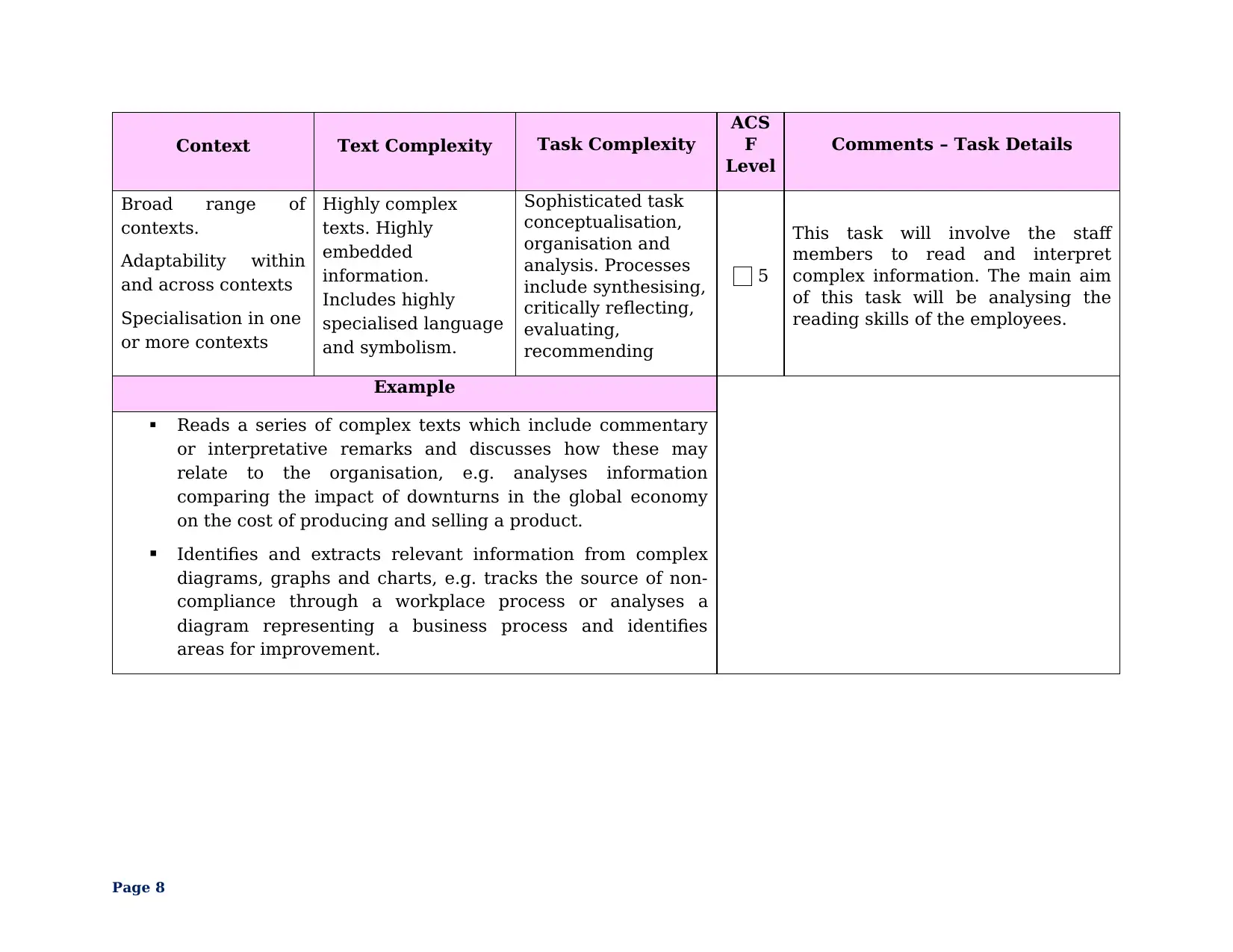
Context Text Complexity Task Complexity
ACS
F
Level
Comments – Task Details
Broad range of
contexts.
Adaptability within
and across contexts
Specialisation in one
or more contexts
Highly complex
texts. Highly
embedded
information.
Includes highly
specialised language
and symbolism.
Sophisticated task
conceptualisation,
organisation and
analysis. Processes
include synthesising,
critically reflecting,
evaluating,
recommending
5
This task will involve the staff
members to read and interpret
complex information. The main aim
of this task will be analysing the
reading skills of the employees.
Example
Reads a series of complex texts which include commentary
or interpretative remarks and discusses how these may
relate to the organisation, e.g. analyses information
comparing the impact of downturns in the global economy
on the cost of producing and selling a product.
Identifies and extracts relevant information from complex
diagrams, graphs and charts, e.g. tracks the source of non-
compliance through a workplace process or analyses a
diagram representing a business process and identifies
areas for improvement.
Page 8
ACS
F
Level
Comments – Task Details
Broad range of
contexts.
Adaptability within
and across contexts
Specialisation in one
or more contexts
Highly complex
texts. Highly
embedded
information.
Includes highly
specialised language
and symbolism.
Sophisticated task
conceptualisation,
organisation and
analysis. Processes
include synthesising,
critically reflecting,
evaluating,
recommending
5
This task will involve the staff
members to read and interpret
complex information. The main aim
of this task will be analysing the
reading skills of the employees.
Example
Reads a series of complex texts which include commentary
or interpretative remarks and discusses how these may
relate to the organisation, e.g. analyses information
comparing the impact of downturns in the global economy
on the cost of producing and selling a product.
Identifies and extracts relevant information from complex
diagrams, graphs and charts, e.g. tracks the source of non-
compliance through a workplace process or analyses a
diagram representing a business process and identifies
areas for improvement.
Page 8
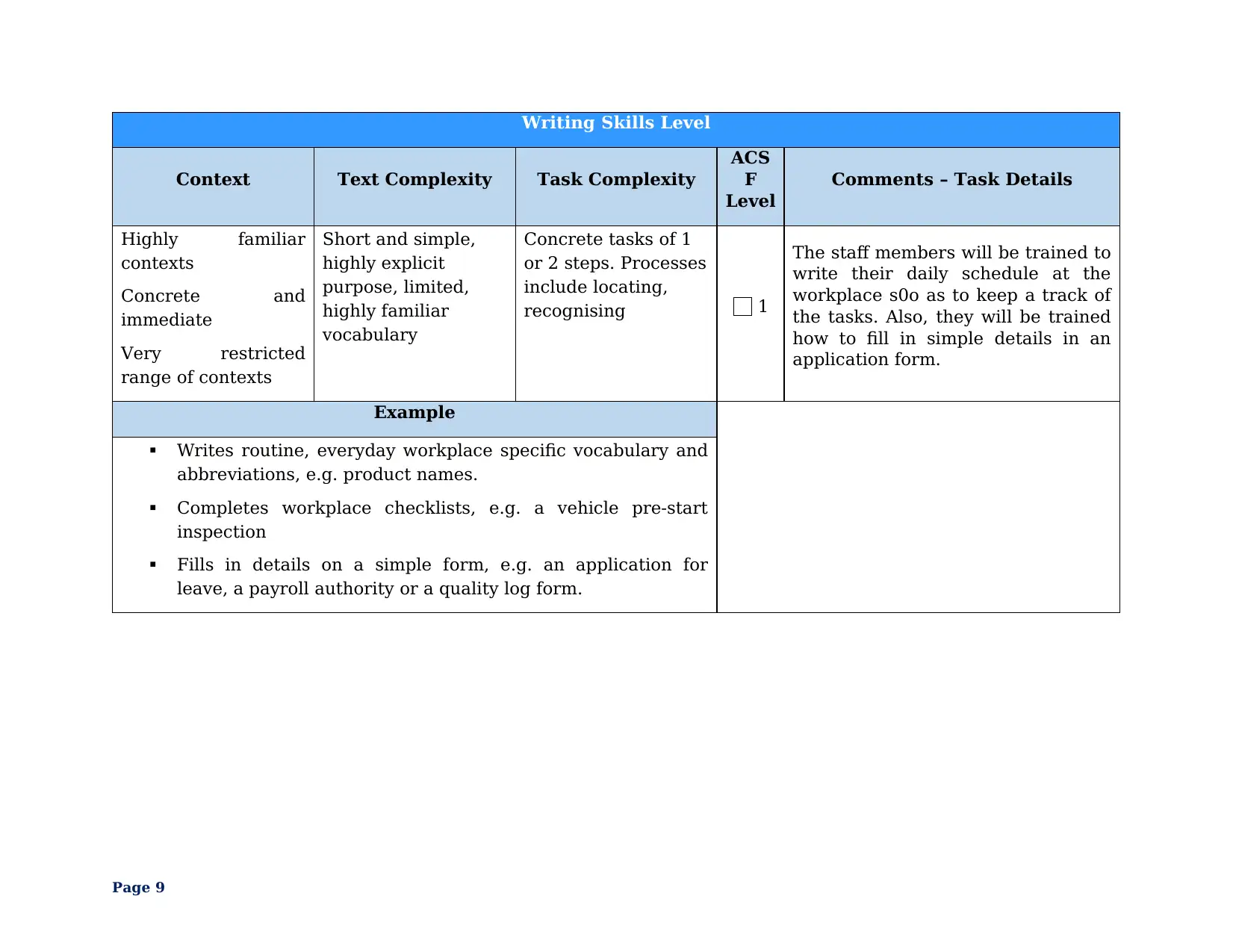
Writing Skills Level
Context Text Complexity Task Complexity
ACS
F
Level
Comments – Task Details
Highly familiar
contexts
Concrete and
immediate
Very restricted
range of contexts
Short and simple,
highly explicit
purpose, limited,
highly familiar
vocabulary
Concrete tasks of 1
or 2 steps. Processes
include locating,
recognising 1
The staff members will be trained to
write their daily schedule at the
workplace s0o as to keep a track of
the tasks. Also, they will be trained
how to fill in simple details in an
application form.
Example
Writes routine, everyday workplace specific vocabulary and
abbreviations, e.g. product names.
Completes workplace checklists, e.g. a vehicle pre-start
inspection
Fills in details on a simple form, e.g. an application for
leave, a payroll authority or a quality log form.
Page 9
Context Text Complexity Task Complexity
ACS
F
Level
Comments – Task Details
Highly familiar
contexts
Concrete and
immediate
Very restricted
range of contexts
Short and simple,
highly explicit
purpose, limited,
highly familiar
vocabulary
Concrete tasks of 1
or 2 steps. Processes
include locating,
recognising 1
The staff members will be trained to
write their daily schedule at the
workplace s0o as to keep a track of
the tasks. Also, they will be trained
how to fill in simple details in an
application form.
Example
Writes routine, everyday workplace specific vocabulary and
abbreviations, e.g. product names.
Completes workplace checklists, e.g. a vehicle pre-start
inspection
Fills in details on a simple form, e.g. an application for
leave, a payroll authority or a quality log form.
Page 9
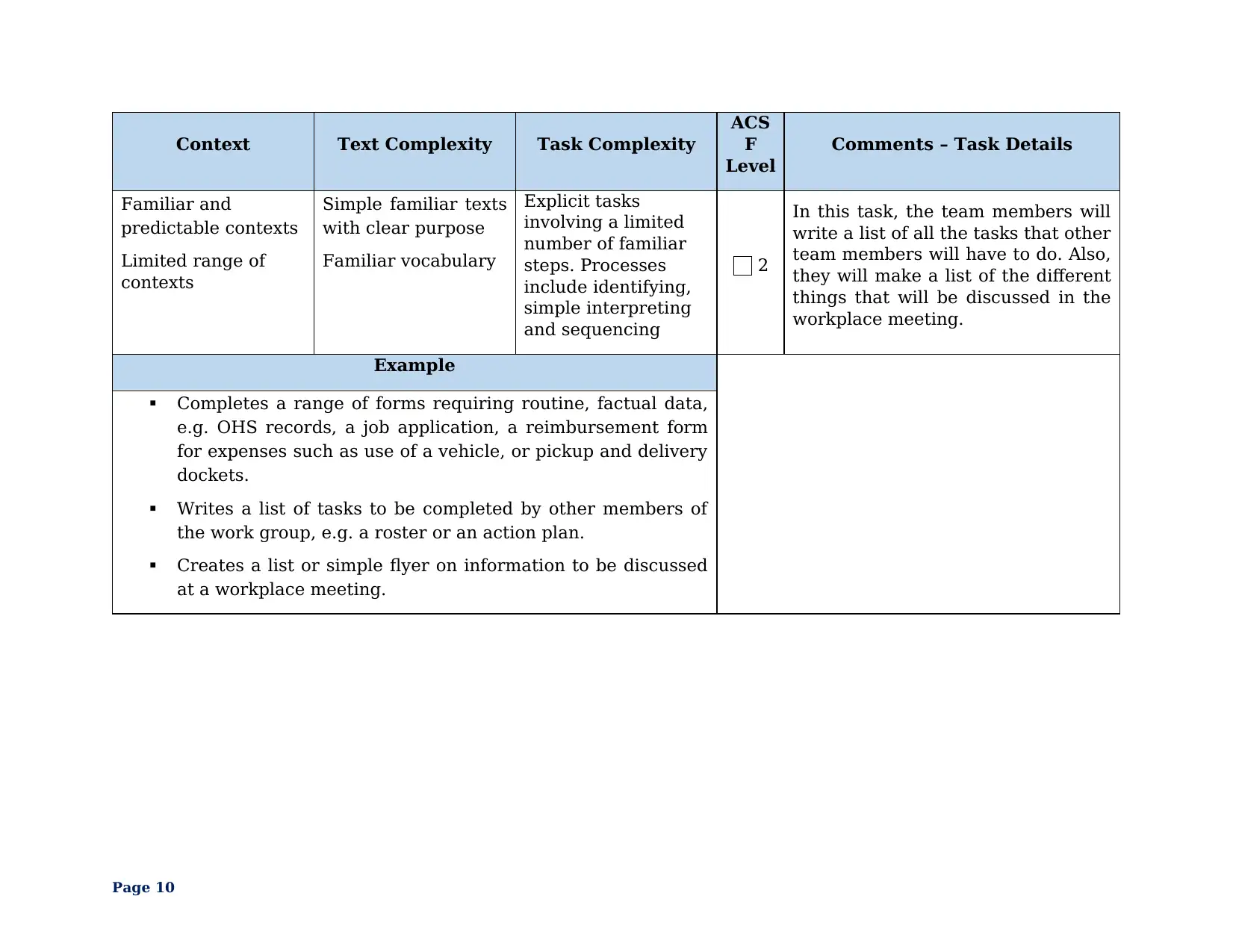
Context Text Complexity Task Complexity
ACS
F
Level
Comments – Task Details
Familiar and
predictable contexts
Limited range of
contexts
Simple familiar texts
with clear purpose
Familiar vocabulary
Explicit tasks
involving a limited
number of familiar
steps. Processes
include identifying,
simple interpreting
and sequencing
2
In this task, the team members will
write a list of all the tasks that other
team members will have to do. Also,
they will make a list of the different
things that will be discussed in the
workplace meeting.
Example
Completes a range of forms requiring routine, factual data,
e.g. OHS records, a job application, a reimbursement form
for expenses such as use of a vehicle, or pickup and delivery
dockets.
Writes a list of tasks to be completed by other members of
the work group, e.g. a roster or an action plan.
Creates a list or simple flyer on information to be discussed
at a workplace meeting.
Page 10
ACS
F
Level
Comments – Task Details
Familiar and
predictable contexts
Limited range of
contexts
Simple familiar texts
with clear purpose
Familiar vocabulary
Explicit tasks
involving a limited
number of familiar
steps. Processes
include identifying,
simple interpreting
and sequencing
2
In this task, the team members will
write a list of all the tasks that other
team members will have to do. Also,
they will make a list of the different
things that will be discussed in the
workplace meeting.
Example
Completes a range of forms requiring routine, factual data,
e.g. OHS records, a job application, a reimbursement form
for expenses such as use of a vehicle, or pickup and delivery
dockets.
Writes a list of tasks to be completed by other members of
the work group, e.g. a roster or an action plan.
Creates a list or simple flyer on information to be discussed
at a workplace meeting.
Page 10
Secure Best Marks with AI Grader
Need help grading? Try our AI Grader for instant feedback on your assignments.
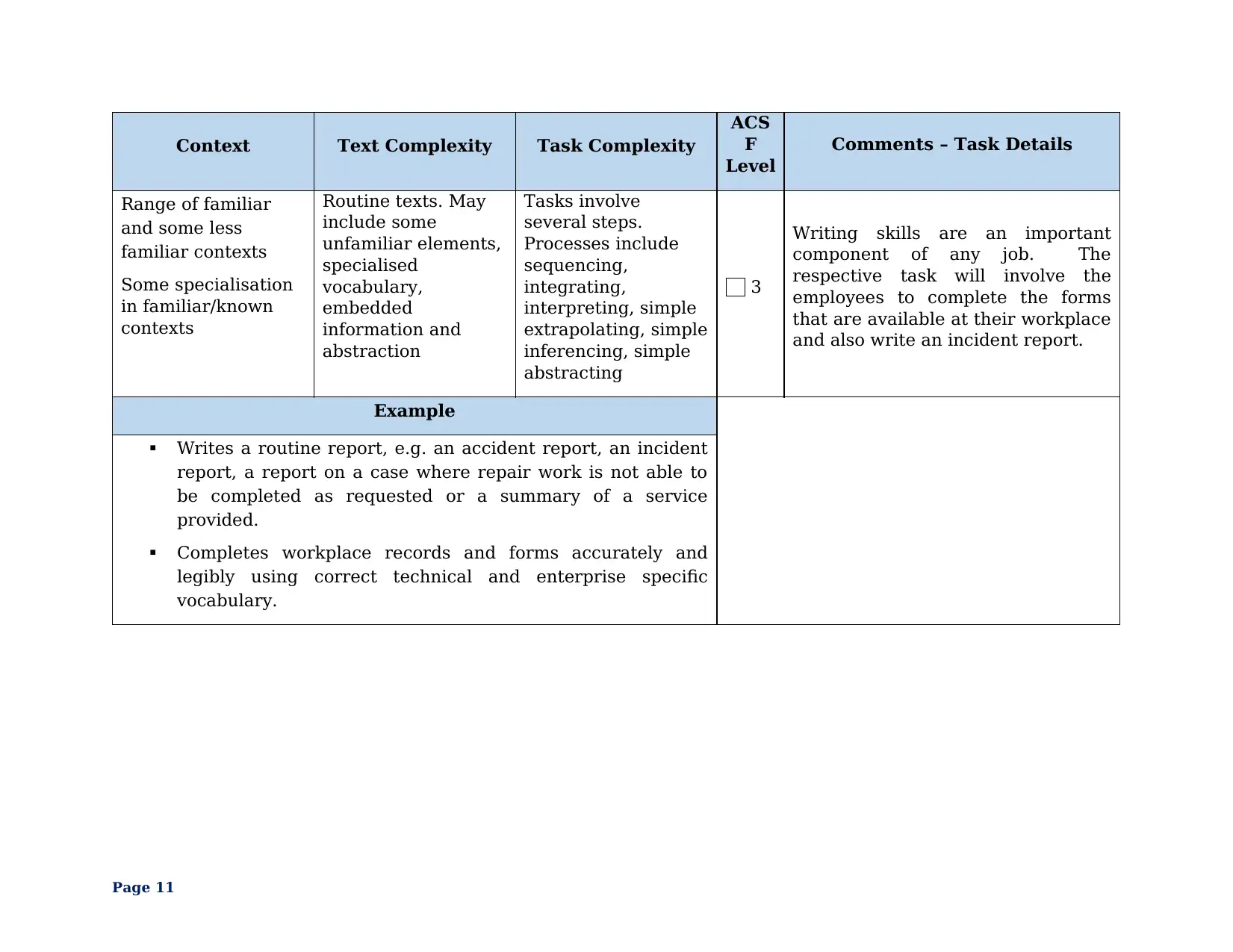
Context Text Complexity Task Complexity
ACS
F
Level
Comments – Task Details
Range of familiar
and some less
familiar contexts
Some specialisation
in familiar/known
contexts
Routine texts. May
include some
unfamiliar elements,
specialised
vocabulary,
embedded
information and
abstraction
Tasks involve
several steps.
Processes include
sequencing,
integrating,
interpreting, simple
extrapolating, simple
inferencing, simple
abstracting
3
Writing skills are an important
component of any job. The
respective task will involve the
employees to complete the forms
that are available at their workplace
and also write an incident report.
Example
Writes a routine report, e.g. an accident report, an incident
report, a report on a case where repair work is not able to
be completed as requested or a summary of a service
provided.
Completes workplace records and forms accurately and
legibly using correct technical and enterprise specific
vocabulary.
Page 11
ACS
F
Level
Comments – Task Details
Range of familiar
and some less
familiar contexts
Some specialisation
in familiar/known
contexts
Routine texts. May
include some
unfamiliar elements,
specialised
vocabulary,
embedded
information and
abstraction
Tasks involve
several steps.
Processes include
sequencing,
integrating,
interpreting, simple
extrapolating, simple
inferencing, simple
abstracting
3
Writing skills are an important
component of any job. The
respective task will involve the
employees to complete the forms
that are available at their workplace
and also write an incident report.
Example
Writes a routine report, e.g. an accident report, an incident
report, a report on a case where repair work is not able to
be completed as requested or a summary of a service
provided.
Completes workplace records and forms accurately and
legibly using correct technical and enterprise specific
vocabulary.
Page 11
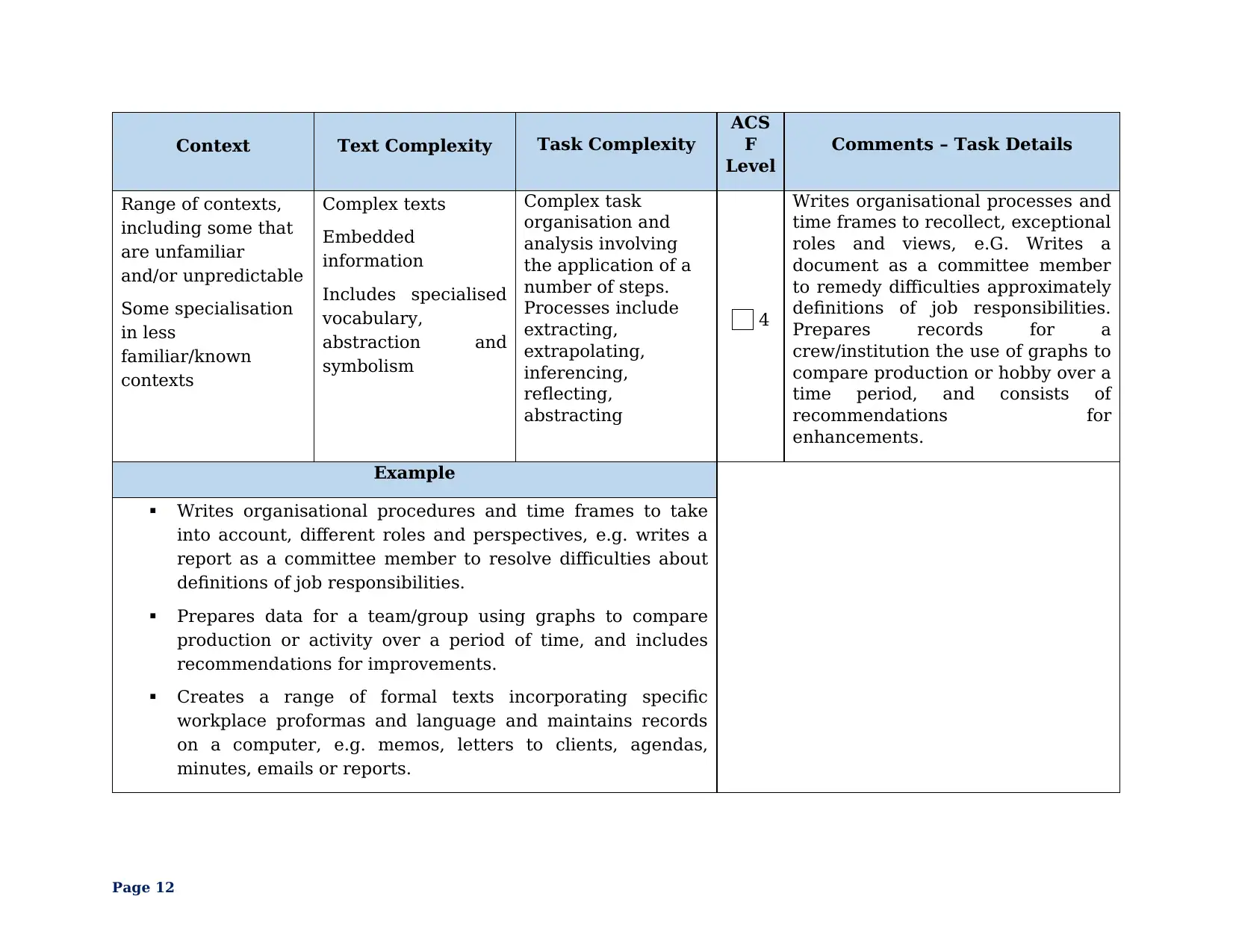
Context Text Complexity Task Complexity
ACS
F
Level
Comments – Task Details
Range of contexts,
including some that
are unfamiliar
and/or unpredictable
Some specialisation
in less
familiar/known
contexts
Complex texts
Embedded
information
Includes specialised
vocabulary,
abstraction and
symbolism
Complex task
organisation and
analysis involving
the application of a
number of steps.
Processes include
extracting,
extrapolating,
inferencing,
reflecting,
abstracting
4
Writes organisational processes and
time frames to recollect, exceptional
roles and views, e.G. Writes a
document as a committee member
to remedy difficulties approximately
definitions of job responsibilities.
Prepares records for a
crew/institution the use of graphs to
compare production or hobby over a
time period, and consists of
recommendations for
enhancements.
Example
Writes organisational procedures and time frames to take
into account, different roles and perspectives, e.g. writes a
report as a committee member to resolve difficulties about
definitions of job responsibilities.
Prepares data for a team/group using graphs to compare
production or activity over a period of time, and includes
recommendations for improvements.
Creates a range of formal texts incorporating specific
workplace proformas and language and maintains records
on a computer, e.g. memos, letters to clients, agendas,
minutes, emails or reports.
Page 12
ACS
F
Level
Comments – Task Details
Range of contexts,
including some that
are unfamiliar
and/or unpredictable
Some specialisation
in less
familiar/known
contexts
Complex texts
Embedded
information
Includes specialised
vocabulary,
abstraction and
symbolism
Complex task
organisation and
analysis involving
the application of a
number of steps.
Processes include
extracting,
extrapolating,
inferencing,
reflecting,
abstracting
4
Writes organisational processes and
time frames to recollect, exceptional
roles and views, e.G. Writes a
document as a committee member
to remedy difficulties approximately
definitions of job responsibilities.
Prepares records for a
crew/institution the use of graphs to
compare production or hobby over a
time period, and consists of
recommendations for
enhancements.
Example
Writes organisational procedures and time frames to take
into account, different roles and perspectives, e.g. writes a
report as a committee member to resolve difficulties about
definitions of job responsibilities.
Prepares data for a team/group using graphs to compare
production or activity over a period of time, and includes
recommendations for improvements.
Creates a range of formal texts incorporating specific
workplace proformas and language and maintains records
on a computer, e.g. memos, letters to clients, agendas,
minutes, emails or reports.
Page 12
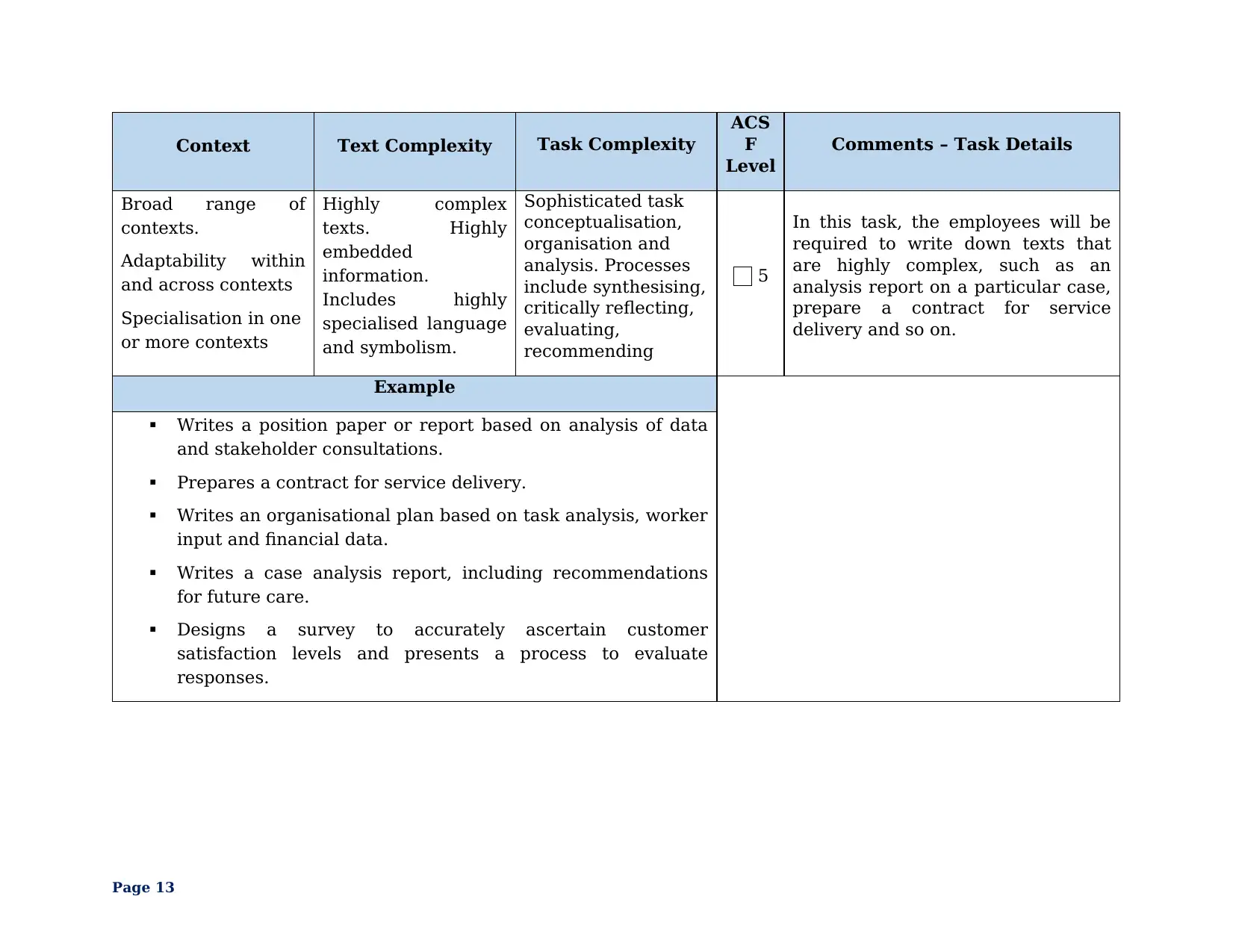
Context Text Complexity Task Complexity
ACS
F
Level
Comments – Task Details
Broad range of
contexts.
Adaptability within
and across contexts
Specialisation in one
or more contexts
Highly complex
texts. Highly
embedded
information.
Includes highly
specialised language
and symbolism.
Sophisticated task
conceptualisation,
organisation and
analysis. Processes
include synthesising,
critically reflecting,
evaluating,
recommending
5
In this task, the employees will be
required to write down texts that
are highly complex, such as an
analysis report on a particular case,
prepare a contract for service
delivery and so on.
Example
Writes a position paper or report based on analysis of data
and stakeholder consultations.
Prepares a contract for service delivery.
Writes an organisational plan based on task analysis, worker
input and financial data.
Writes a case analysis report, including recommendations
for future care.
Designs a survey to accurately ascertain customer
satisfaction levels and presents a process to evaluate
responses.
Page 13
ACS
F
Level
Comments – Task Details
Broad range of
contexts.
Adaptability within
and across contexts
Specialisation in one
or more contexts
Highly complex
texts. Highly
embedded
information.
Includes highly
specialised language
and symbolism.
Sophisticated task
conceptualisation,
organisation and
analysis. Processes
include synthesising,
critically reflecting,
evaluating,
recommending
5
In this task, the employees will be
required to write down texts that
are highly complex, such as an
analysis report on a particular case,
prepare a contract for service
delivery and so on.
Example
Writes a position paper or report based on analysis of data
and stakeholder consultations.
Prepares a contract for service delivery.
Writes an organisational plan based on task analysis, worker
input and financial data.
Writes a case analysis report, including recommendations
for future care.
Designs a survey to accurately ascertain customer
satisfaction levels and presents a process to evaluate
responses.
Page 13
Paraphrase This Document
Need a fresh take? Get an instant paraphrase of this document with our AI Paraphraser
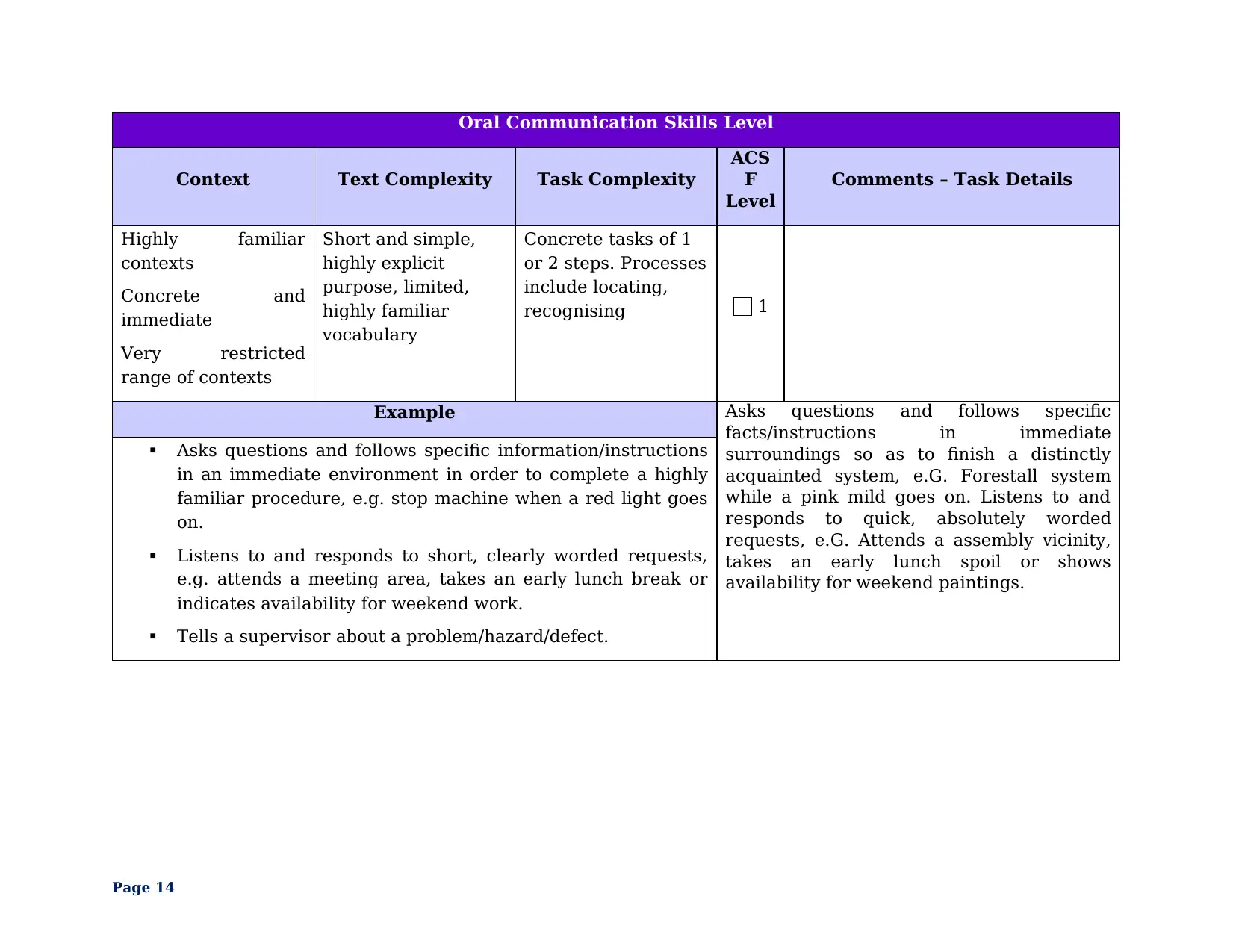
Oral Communication Skills Level
Context Text Complexity Task Complexity
ACS
F
Level
Comments – Task Details
Highly familiar
contexts
Concrete and
immediate
Very restricted
range of contexts
Short and simple,
highly explicit
purpose, limited,
highly familiar
vocabulary
Concrete tasks of 1
or 2 steps. Processes
include locating,
recognising 1
Example Asks questions and follows specific
facts/instructions in immediate
surroundings so as to finish a distinctly
acquainted system, e.G. Forestall system
while a pink mild goes on. Listens to and
responds to quick, absolutely worded
requests, e.G. Attends a assembly vicinity,
takes an early lunch spoil or shows
availability for weekend paintings.
Asks questions and follows specific information/instructions
in an immediate environment in order to complete a highly
familiar procedure, e.g. stop machine when a red light goes
on.
Listens to and responds to short, clearly worded requests,
e.g. attends a meeting area, takes an early lunch break or
indicates availability for weekend work.
Tells a supervisor about a problem/hazard/defect.
Page 14
Context Text Complexity Task Complexity
ACS
F
Level
Comments – Task Details
Highly familiar
contexts
Concrete and
immediate
Very restricted
range of contexts
Short and simple,
highly explicit
purpose, limited,
highly familiar
vocabulary
Concrete tasks of 1
or 2 steps. Processes
include locating,
recognising 1
Example Asks questions and follows specific
facts/instructions in immediate
surroundings so as to finish a distinctly
acquainted system, e.G. Forestall system
while a pink mild goes on. Listens to and
responds to quick, absolutely worded
requests, e.G. Attends a assembly vicinity,
takes an early lunch spoil or shows
availability for weekend paintings.
Asks questions and follows specific information/instructions
in an immediate environment in order to complete a highly
familiar procedure, e.g. stop machine when a red light goes
on.
Listens to and responds to short, clearly worded requests,
e.g. attends a meeting area, takes an early lunch break or
indicates availability for weekend work.
Tells a supervisor about a problem/hazard/defect.
Page 14
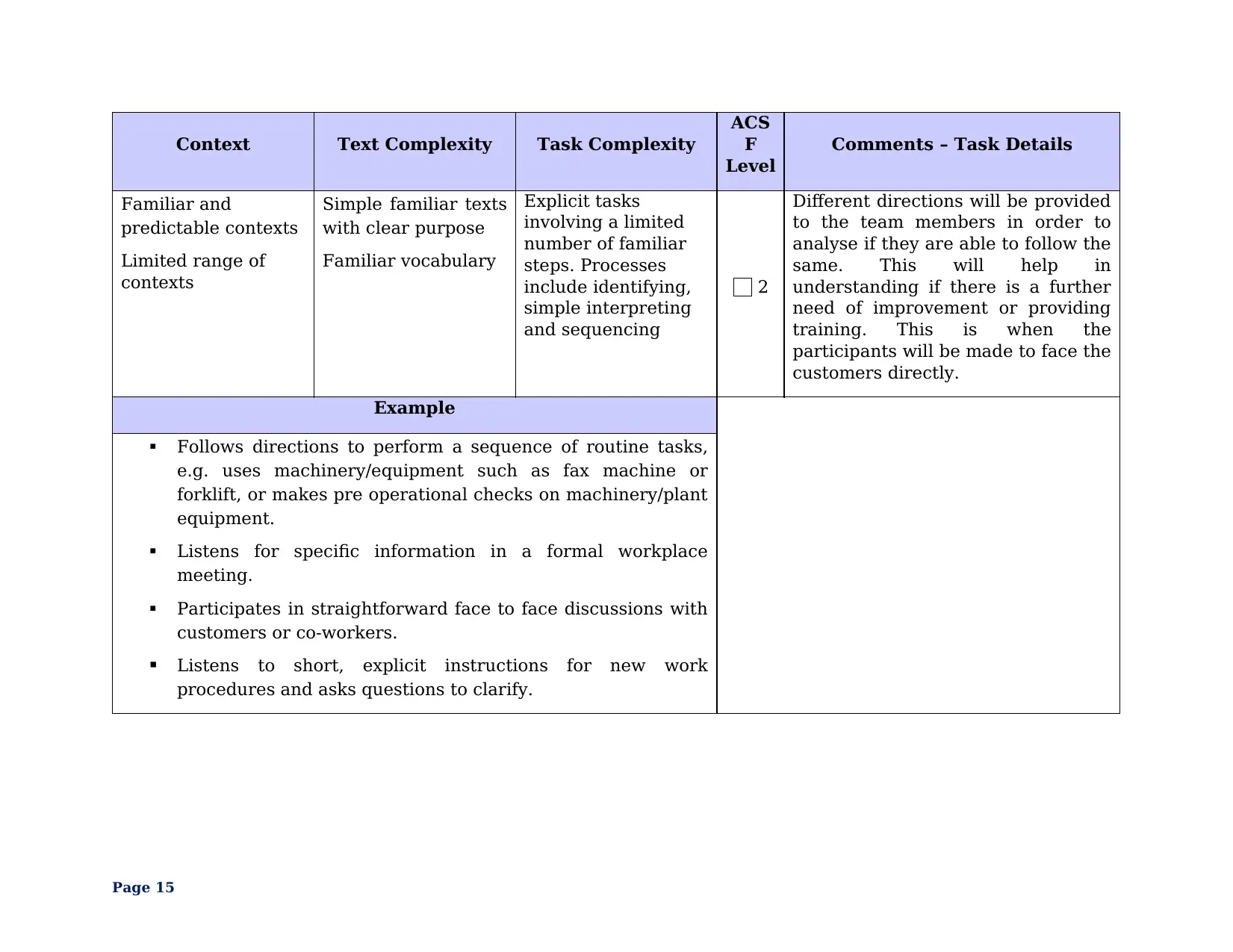
Context Text Complexity Task Complexity
ACS
F
Level
Comments – Task Details
Familiar and
predictable contexts
Limited range of
contexts
Simple familiar texts
with clear purpose
Familiar vocabulary
Explicit tasks
involving a limited
number of familiar
steps. Processes
include identifying,
simple interpreting
and sequencing
2
Different directions will be provided
to the team members in order to
analyse if they are able to follow the
same. This will help in
understanding if there is a further
need of improvement or providing
training. This is when the
participants will be made to face the
customers directly.
Example
Follows directions to perform a sequence of routine tasks,
e.g. uses machinery/equipment such as fax machine or
forklift, or makes pre operational checks on machinery/plant
equipment.
Listens for specific information in a formal workplace
meeting.
Participates in straightforward face to face discussions with
customers or co-workers.
Listens to short, explicit instructions for new work
procedures and asks questions to clarify.
Page 15
ACS
F
Level
Comments – Task Details
Familiar and
predictable contexts
Limited range of
contexts
Simple familiar texts
with clear purpose
Familiar vocabulary
Explicit tasks
involving a limited
number of familiar
steps. Processes
include identifying,
simple interpreting
and sequencing
2
Different directions will be provided
to the team members in order to
analyse if they are able to follow the
same. This will help in
understanding if there is a further
need of improvement or providing
training. This is when the
participants will be made to face the
customers directly.
Example
Follows directions to perform a sequence of routine tasks,
e.g. uses machinery/equipment such as fax machine or
forklift, or makes pre operational checks on machinery/plant
equipment.
Listens for specific information in a formal workplace
meeting.
Participates in straightforward face to face discussions with
customers or co-workers.
Listens to short, explicit instructions for new work
procedures and asks questions to clarify.
Page 15
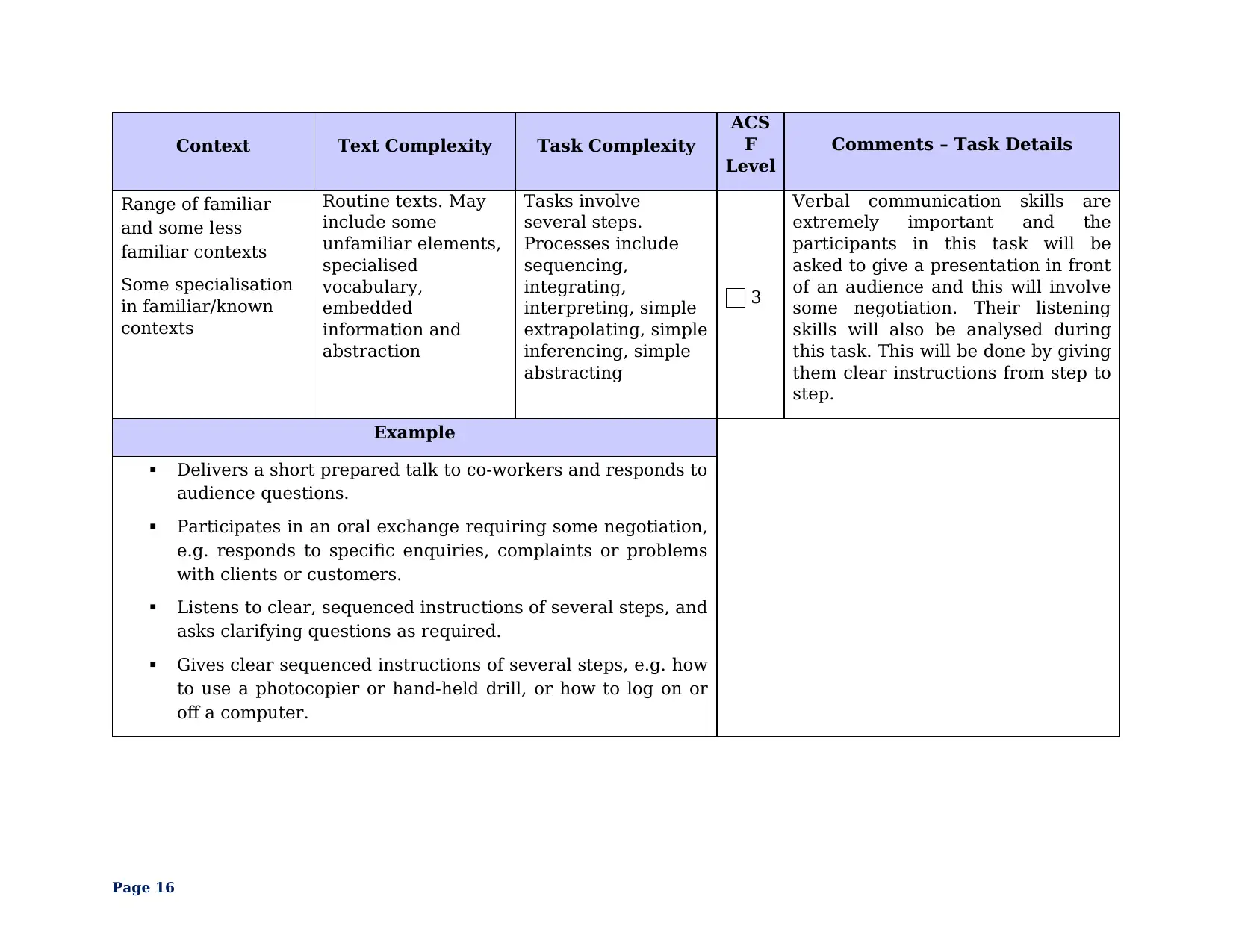
Context Text Complexity Task Complexity
ACS
F
Level
Comments – Task Details
Range of familiar
and some less
familiar contexts
Some specialisation
in familiar/known
contexts
Routine texts. May
include some
unfamiliar elements,
specialised
vocabulary,
embedded
information and
abstraction
Tasks involve
several steps.
Processes include
sequencing,
integrating,
interpreting, simple
extrapolating, simple
inferencing, simple
abstracting
3
Verbal communication skills are
extremely important and the
participants in this task will be
asked to give a presentation in front
of an audience and this will involve
some negotiation. Their listening
skills will also be analysed during
this task. This will be done by giving
them clear instructions from step to
step.
Example
Delivers a short prepared talk to co-workers and responds to
audience questions.
Participates in an oral exchange requiring some negotiation,
e.g. responds to specific enquiries, complaints or problems
with clients or customers.
Listens to clear, sequenced instructions of several steps, and
asks clarifying questions as required.
Gives clear sequenced instructions of several steps, e.g. how
to use a photocopier or hand-held drill, or how to log on or
off a computer.
Page 16
ACS
F
Level
Comments – Task Details
Range of familiar
and some less
familiar contexts
Some specialisation
in familiar/known
contexts
Routine texts. May
include some
unfamiliar elements,
specialised
vocabulary,
embedded
information and
abstraction
Tasks involve
several steps.
Processes include
sequencing,
integrating,
interpreting, simple
extrapolating, simple
inferencing, simple
abstracting
3
Verbal communication skills are
extremely important and the
participants in this task will be
asked to give a presentation in front
of an audience and this will involve
some negotiation. Their listening
skills will also be analysed during
this task. This will be done by giving
them clear instructions from step to
step.
Example
Delivers a short prepared talk to co-workers and responds to
audience questions.
Participates in an oral exchange requiring some negotiation,
e.g. responds to specific enquiries, complaints or problems
with clients or customers.
Listens to clear, sequenced instructions of several steps, and
asks clarifying questions as required.
Gives clear sequenced instructions of several steps, e.g. how
to use a photocopier or hand-held drill, or how to log on or
off a computer.
Page 16
Secure Best Marks with AI Grader
Need help grading? Try our AI Grader for instant feedback on your assignments.
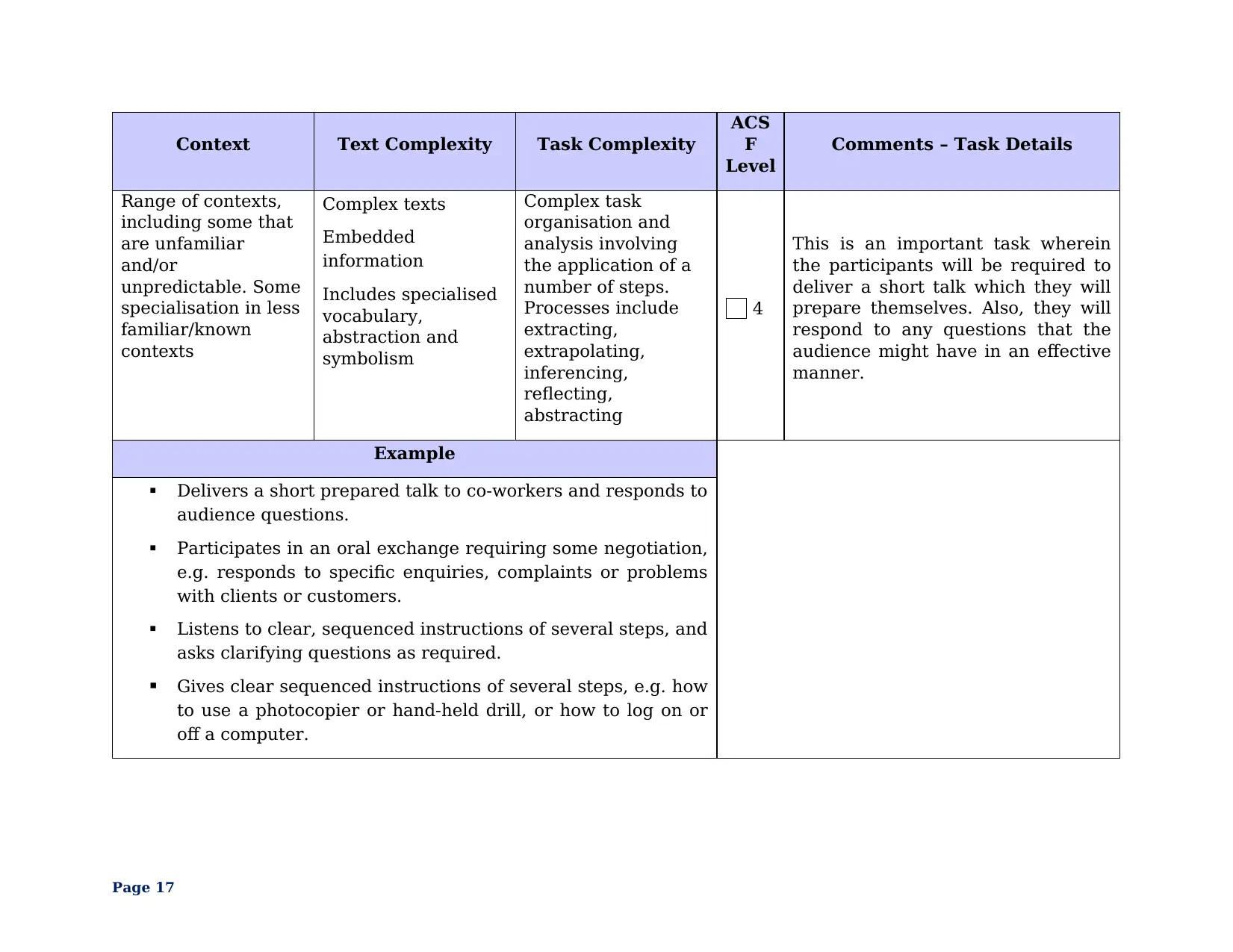
Context Text Complexity Task Complexity
ACS
F
Level
Comments – Task Details
Range of contexts,
including some that
are unfamiliar
and/or
unpredictable. Some
specialisation in less
familiar/known
contexts
Complex texts
Embedded
information
Includes specialised
vocabulary,
abstraction and
symbolism
Complex task
organisation and
analysis involving
the application of a
number of steps.
Processes include
extracting,
extrapolating,
inferencing,
reflecting,
abstracting
4
This is an important task wherein
the participants will be required to
deliver a short talk which they will
prepare themselves. Also, they will
respond to any questions that the
audience might have in an effective
manner.
Example
Delivers a short prepared talk to co-workers and responds to
audience questions.
Participates in an oral exchange requiring some negotiation,
e.g. responds to specific enquiries, complaints or problems
with clients or customers.
Listens to clear, sequenced instructions of several steps, and
asks clarifying questions as required.
Gives clear sequenced instructions of several steps, e.g. how
to use a photocopier or hand-held drill, or how to log on or
off a computer.
Page 17
ACS
F
Level
Comments – Task Details
Range of contexts,
including some that
are unfamiliar
and/or
unpredictable. Some
specialisation in less
familiar/known
contexts
Complex texts
Embedded
information
Includes specialised
vocabulary,
abstraction and
symbolism
Complex task
organisation and
analysis involving
the application of a
number of steps.
Processes include
extracting,
extrapolating,
inferencing,
reflecting,
abstracting
4
This is an important task wherein
the participants will be required to
deliver a short talk which they will
prepare themselves. Also, they will
respond to any questions that the
audience might have in an effective
manner.
Example
Delivers a short prepared talk to co-workers and responds to
audience questions.
Participates in an oral exchange requiring some negotiation,
e.g. responds to specific enquiries, complaints or problems
with clients or customers.
Listens to clear, sequenced instructions of several steps, and
asks clarifying questions as required.
Gives clear sequenced instructions of several steps, e.g. how
to use a photocopier or hand-held drill, or how to log on or
off a computer.
Page 17
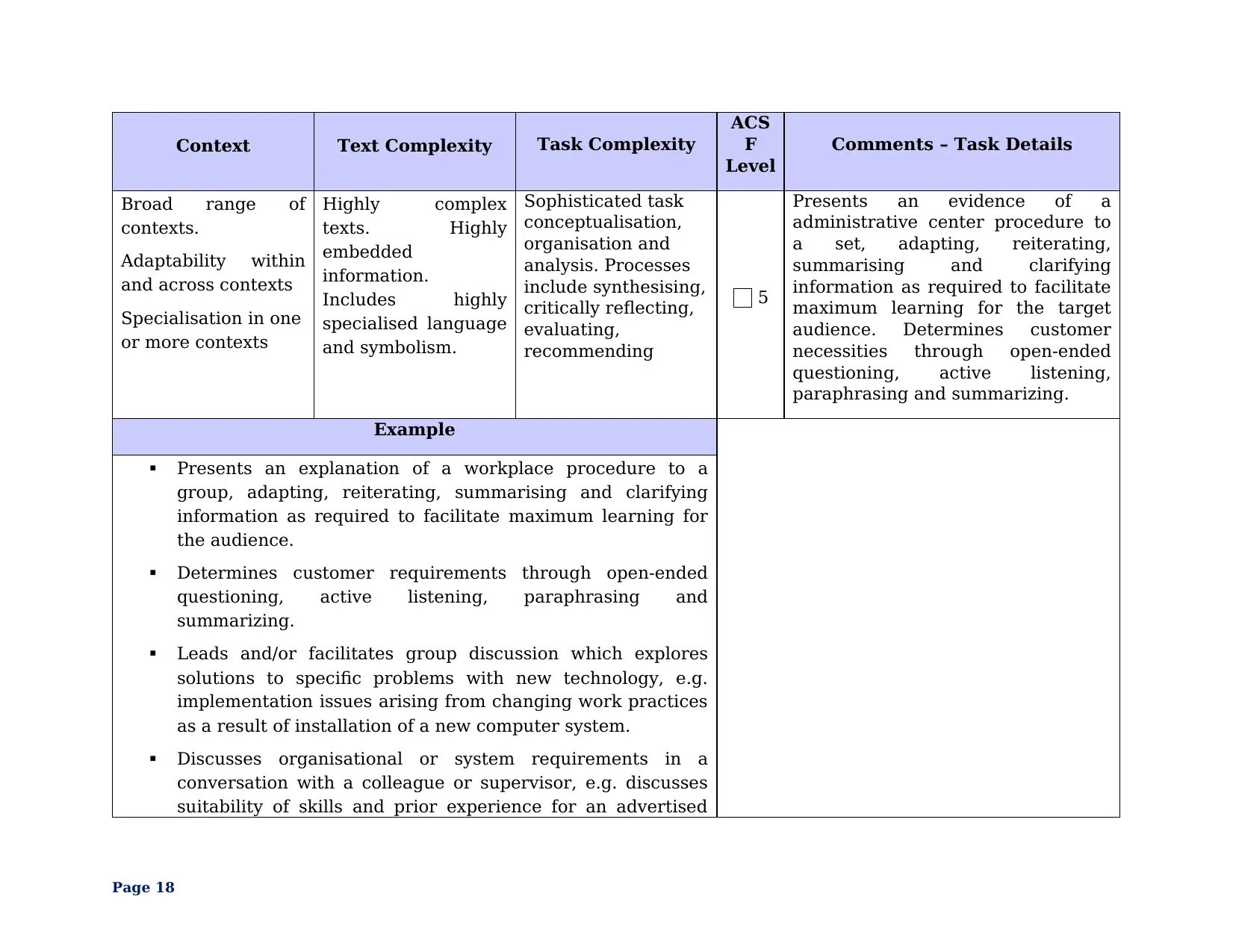
Context Text Complexity Task Complexity
ACS
F
Level
Comments – Task Details
Broad range of
contexts.
Adaptability within
and across contexts
Specialisation in one
or more contexts
Highly complex
texts. Highly
embedded
information.
Includes highly
specialised language
and symbolism.
Sophisticated task
conceptualisation,
organisation and
analysis. Processes
include synthesising,
critically reflecting,
evaluating,
recommending
5
Presents an evidence of a
administrative center procedure to
a set, adapting, reiterating,
summarising and clarifying
information as required to facilitate
maximum learning for the target
audience. Determines customer
necessities through open-ended
questioning, active listening,
paraphrasing and summarizing.
Example
Presents an explanation of a workplace procedure to a
group, adapting, reiterating, summarising and clarifying
information as required to facilitate maximum learning for
the audience.
Determines customer requirements through open-ended
questioning, active listening, paraphrasing and
summarizing.
Leads and/or facilitates group discussion which explores
solutions to specific problems with new technology, e.g.
implementation issues arising from changing work practices
as a result of installation of a new computer system.
Discusses organisational or system requirements in a
conversation with a colleague or supervisor, e.g. discusses
suitability of skills and prior experience for an advertised
Page 18
ACS
F
Level
Comments – Task Details
Broad range of
contexts.
Adaptability within
and across contexts
Specialisation in one
or more contexts
Highly complex
texts. Highly
embedded
information.
Includes highly
specialised language
and symbolism.
Sophisticated task
conceptualisation,
organisation and
analysis. Processes
include synthesising,
critically reflecting,
evaluating,
recommending
5
Presents an evidence of a
administrative center procedure to
a set, adapting, reiterating,
summarising and clarifying
information as required to facilitate
maximum learning for the target
audience. Determines customer
necessities through open-ended
questioning, active listening,
paraphrasing and summarizing.
Example
Presents an explanation of a workplace procedure to a
group, adapting, reiterating, summarising and clarifying
information as required to facilitate maximum learning for
the audience.
Determines customer requirements through open-ended
questioning, active listening, paraphrasing and
summarizing.
Leads and/or facilitates group discussion which explores
solutions to specific problems with new technology, e.g.
implementation issues arising from changing work practices
as a result of installation of a new computer system.
Discusses organisational or system requirements in a
conversation with a colleague or supervisor, e.g. discusses
suitability of skills and prior experience for an advertised
Page 18
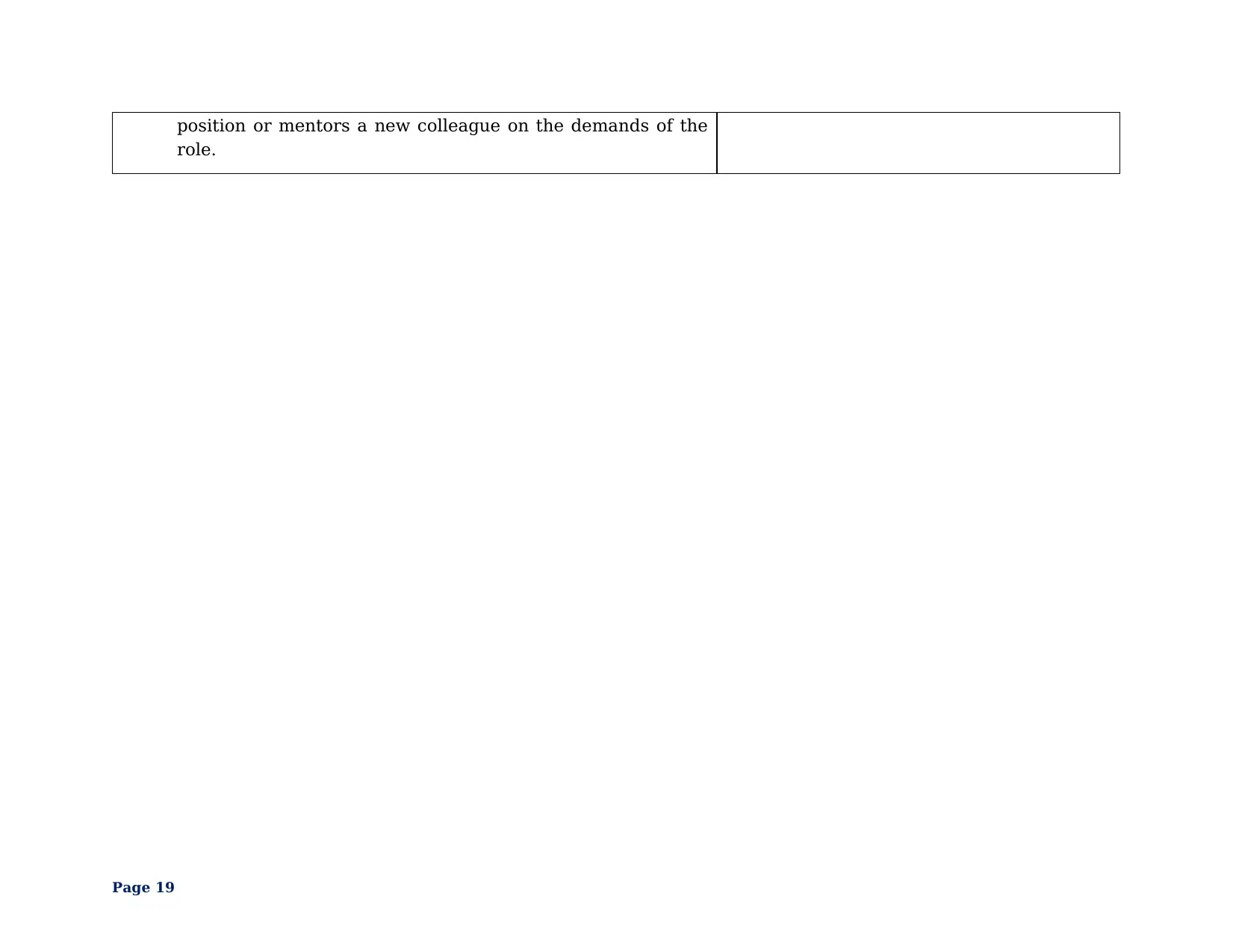
position or mentors a new colleague on the demands of the
role.
Page 19
role.
Page 19
Paraphrase This Document
Need a fresh take? Get an instant paraphrase of this document with our AI Paraphraser
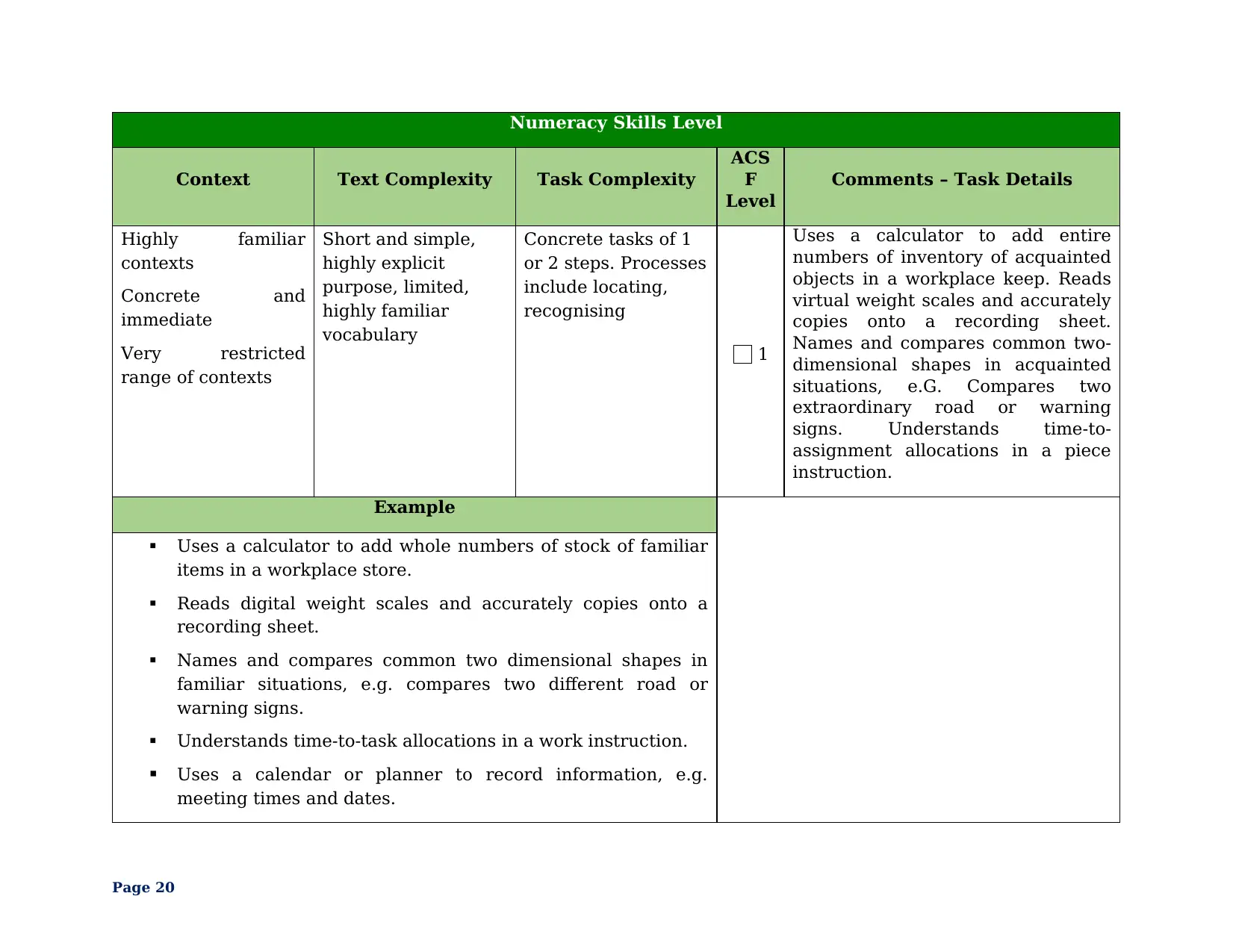
Numeracy Skills Level
Context Text Complexity Task Complexity
ACS
F
Level
Comments – Task Details
Highly familiar
contexts
Concrete and
immediate
Very restricted
range of contexts
Short and simple,
highly explicit
purpose, limited,
highly familiar
vocabulary
Concrete tasks of 1
or 2 steps. Processes
include locating,
recognising
1
Uses a calculator to add entire
numbers of inventory of acquainted
objects in a workplace keep. Reads
virtual weight scales and accurately
copies onto a recording sheet.
Names and compares common two-
dimensional shapes in acquainted
situations, e.G. Compares two
extraordinary road or warning
signs. Understands time-to-
assignment allocations in a piece
instruction.
Example
Uses a calculator to add whole numbers of stock of familiar
items in a workplace store.
Reads digital weight scales and accurately copies onto a
recording sheet.
Names and compares common two dimensional shapes in
familiar situations, e.g. compares two different road or
warning signs.
Understands time-to-task allocations in a work instruction.
Uses a calendar or planner to record information, e.g.
meeting times and dates.
Page 20
Context Text Complexity Task Complexity
ACS
F
Level
Comments – Task Details
Highly familiar
contexts
Concrete and
immediate
Very restricted
range of contexts
Short and simple,
highly explicit
purpose, limited,
highly familiar
vocabulary
Concrete tasks of 1
or 2 steps. Processes
include locating,
recognising
1
Uses a calculator to add entire
numbers of inventory of acquainted
objects in a workplace keep. Reads
virtual weight scales and accurately
copies onto a recording sheet.
Names and compares common two-
dimensional shapes in acquainted
situations, e.G. Compares two
extraordinary road or warning
signs. Understands time-to-
assignment allocations in a piece
instruction.
Example
Uses a calculator to add whole numbers of stock of familiar
items in a workplace store.
Reads digital weight scales and accurately copies onto a
recording sheet.
Names and compares common two dimensional shapes in
familiar situations, e.g. compares two different road or
warning signs.
Understands time-to-task allocations in a work instruction.
Uses a calendar or planner to record information, e.g.
meeting times and dates.
Page 20

Page 21
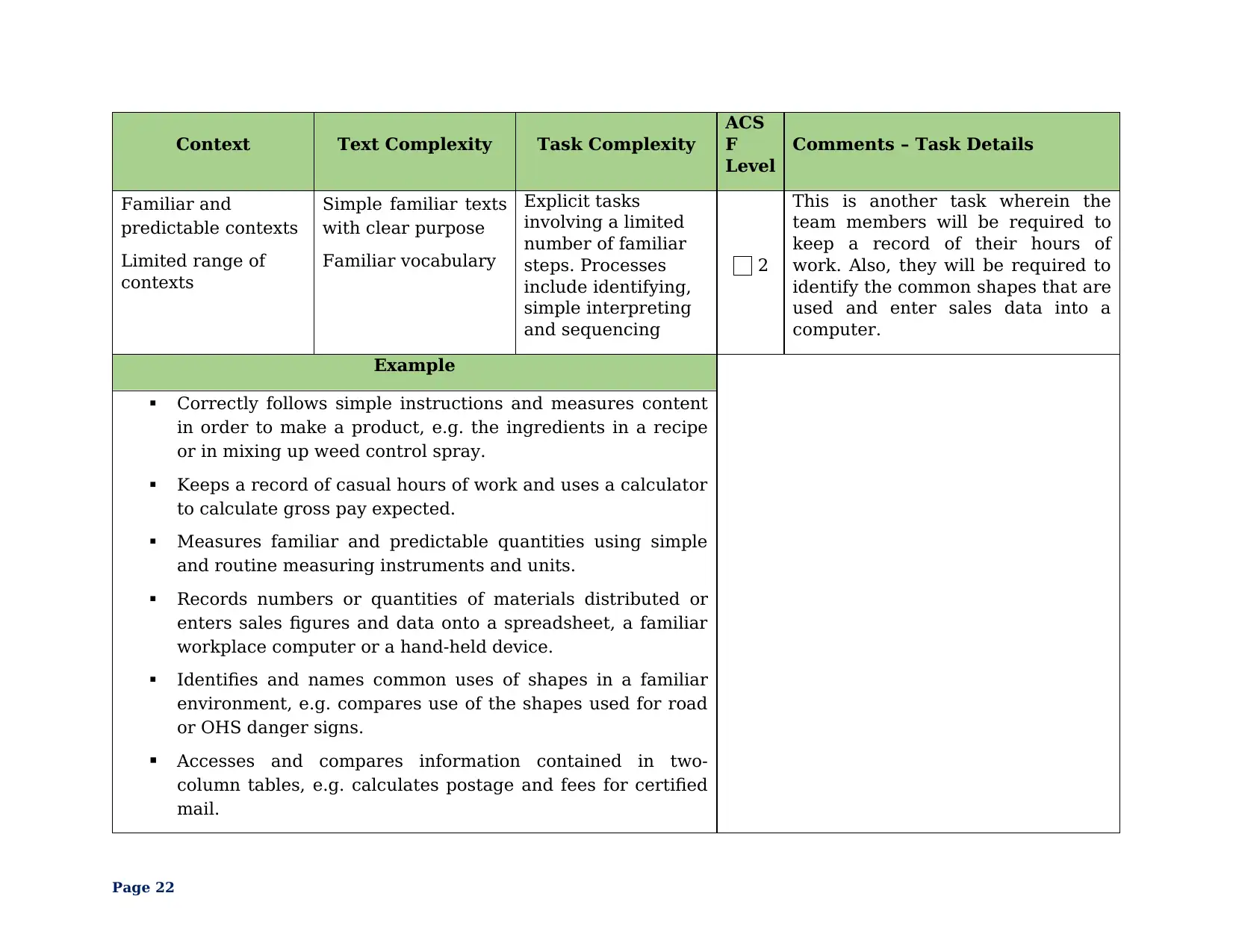
Context Text Complexity Task Complexity
ACS
F
Level
Comments – Task Details
Familiar and
predictable contexts
Limited range of
contexts
Simple familiar texts
with clear purpose
Familiar vocabulary
Explicit tasks
involving a limited
number of familiar
steps. Processes
include identifying,
simple interpreting
and sequencing
2
This is another task wherein the
team members will be required to
keep a record of their hours of
work. Also, they will be required to
identify the common shapes that are
used and enter sales data into a
computer.
Example
Correctly follows simple instructions and measures content
in order to make a product, e.g. the ingredients in a recipe
or in mixing up weed control spray.
Keeps a record of casual hours of work and uses a calculator
to calculate gross pay expected.
Measures familiar and predictable quantities using simple
and routine measuring instruments and units.
Records numbers or quantities of materials distributed or
enters sales figures and data onto a spreadsheet, a familiar
workplace computer or a hand-held device.
Identifies and names common uses of shapes in a familiar
environment, e.g. compares use of the shapes used for road
or OHS danger signs.
Accesses and compares information contained in two-
column tables, e.g. calculates postage and fees for certified
mail.
Page 22
ACS
F
Level
Comments – Task Details
Familiar and
predictable contexts
Limited range of
contexts
Simple familiar texts
with clear purpose
Familiar vocabulary
Explicit tasks
involving a limited
number of familiar
steps. Processes
include identifying,
simple interpreting
and sequencing
2
This is another task wherein the
team members will be required to
keep a record of their hours of
work. Also, they will be required to
identify the common shapes that are
used and enter sales data into a
computer.
Example
Correctly follows simple instructions and measures content
in order to make a product, e.g. the ingredients in a recipe
or in mixing up weed control spray.
Keeps a record of casual hours of work and uses a calculator
to calculate gross pay expected.
Measures familiar and predictable quantities using simple
and routine measuring instruments and units.
Records numbers or quantities of materials distributed or
enters sales figures and data onto a spreadsheet, a familiar
workplace computer or a hand-held device.
Identifies and names common uses of shapes in a familiar
environment, e.g. compares use of the shapes used for road
or OHS danger signs.
Accesses and compares information contained in two-
column tables, e.g. calculates postage and fees for certified
mail.
Page 22
Secure Best Marks with AI Grader
Need help grading? Try our AI Grader for instant feedback on your assignments.

Page 23
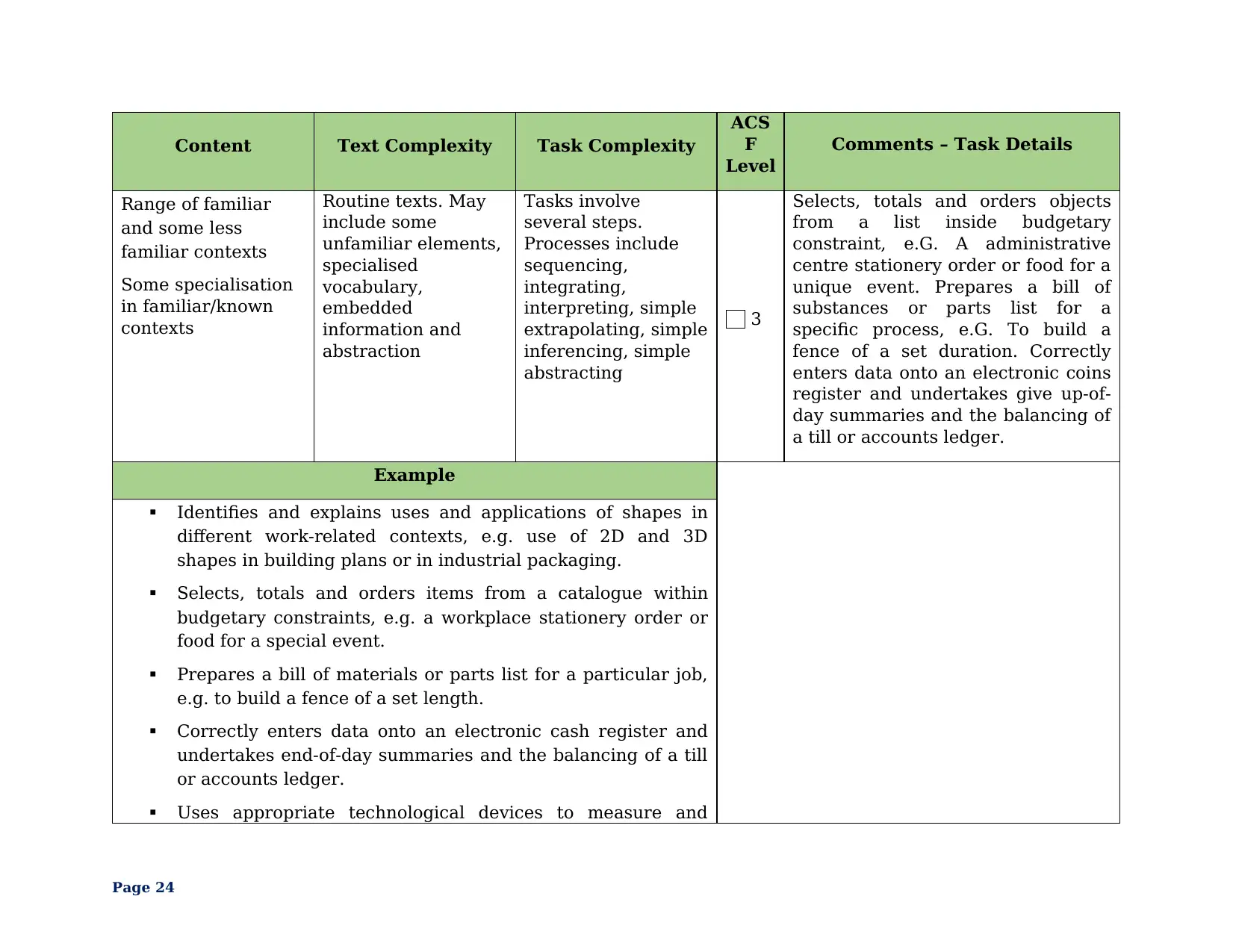
Content Text Complexity Task Complexity
ACS
F
Level
Comments – Task Details
Range of familiar
and some less
familiar contexts
Some specialisation
in familiar/known
contexts
Routine texts. May
include some
unfamiliar elements,
specialised
vocabulary,
embedded
information and
abstraction
Tasks involve
several steps.
Processes include
sequencing,
integrating,
interpreting, simple
extrapolating, simple
inferencing, simple
abstracting
3
Selects, totals and orders objects
from a list inside budgetary
constraint, e.G. A administrative
centre stationery order or food for a
unique event. Prepares a bill of
substances or parts list for a
specific process, e.G. To build a
fence of a set duration. Correctly
enters data onto an electronic coins
register and undertakes give up-of-
day summaries and the balancing of
a till or accounts ledger.
Example
Identifies and explains uses and applications of shapes in
different work-related contexts, e.g. use of 2D and 3D
shapes in building plans or in industrial packaging.
Selects, totals and orders items from a catalogue within
budgetary constraints, e.g. a workplace stationery order or
food for a special event.
Prepares a bill of materials or parts list for a particular job,
e.g. to build a fence of a set length.
Correctly enters data onto an electronic cash register and
undertakes end-of-day summaries and the balancing of a till
or accounts ledger.
Uses appropriate technological devices to measure and
Page 24
ACS
F
Level
Comments – Task Details
Range of familiar
and some less
familiar contexts
Some specialisation
in familiar/known
contexts
Routine texts. May
include some
unfamiliar elements,
specialised
vocabulary,
embedded
information and
abstraction
Tasks involve
several steps.
Processes include
sequencing,
integrating,
interpreting, simple
extrapolating, simple
inferencing, simple
abstracting
3
Selects, totals and orders objects
from a list inside budgetary
constraint, e.G. A administrative
centre stationery order or food for a
unique event. Prepares a bill of
substances or parts list for a
specific process, e.G. To build a
fence of a set duration. Correctly
enters data onto an electronic coins
register and undertakes give up-of-
day summaries and the balancing of
a till or accounts ledger.
Example
Identifies and explains uses and applications of shapes in
different work-related contexts, e.g. use of 2D and 3D
shapes in building plans or in industrial packaging.
Selects, totals and orders items from a catalogue within
budgetary constraints, e.g. a workplace stationery order or
food for a special event.
Prepares a bill of materials or parts list for a particular job,
e.g. to build a fence of a set length.
Correctly enters data onto an electronic cash register and
undertakes end-of-day summaries and the balancing of a till
or accounts ledger.
Uses appropriate technological devices to measure and
Page 24
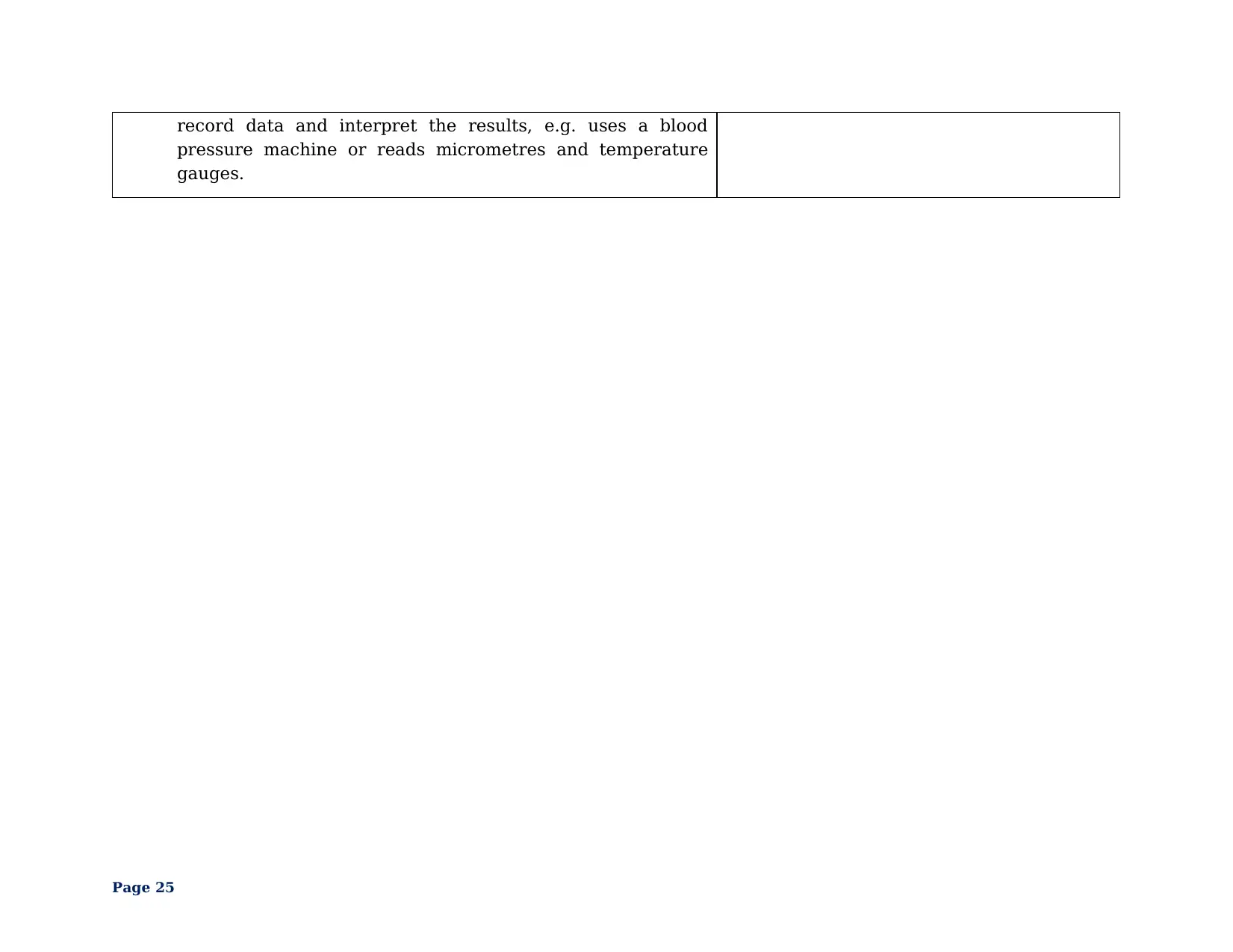
record data and interpret the results, e.g. uses a blood
pressure machine or reads micrometres and temperature
gauges.
Page 25
pressure machine or reads micrometres and temperature
gauges.
Page 25
Paraphrase This Document
Need a fresh take? Get an instant paraphrase of this document with our AI Paraphraser
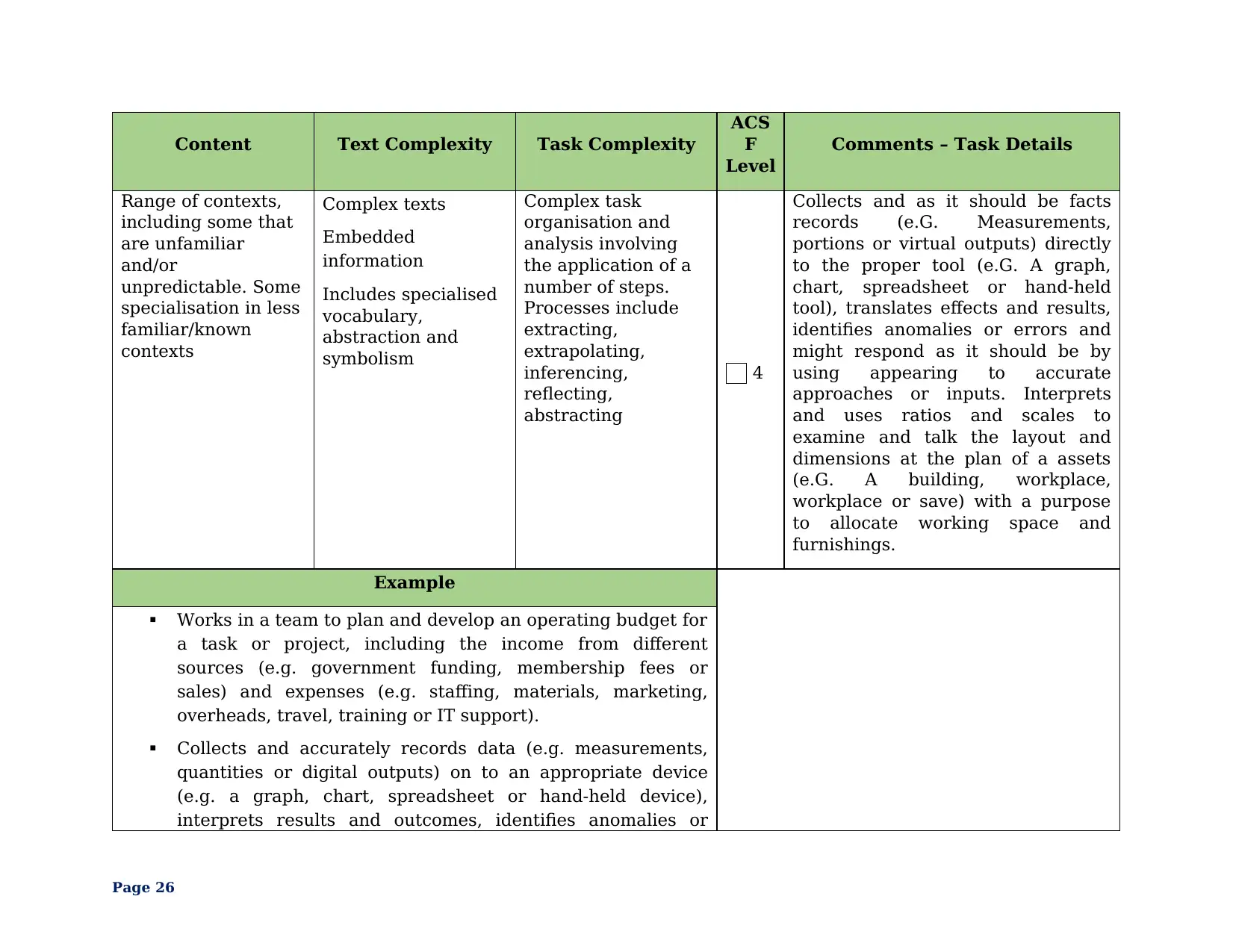
Content Text Complexity Task Complexity
ACS
F
Level
Comments – Task Details
Range of contexts,
including some that
are unfamiliar
and/or
unpredictable. Some
specialisation in less
familiar/known
contexts
Complex texts
Embedded
information
Includes specialised
vocabulary,
abstraction and
symbolism
Complex task
organisation and
analysis involving
the application of a
number of steps.
Processes include
extracting,
extrapolating,
inferencing,
reflecting,
abstracting
4
Collects and as it should be facts
records (e.G. Measurements,
portions or virtual outputs) directly
to the proper tool (e.G. A graph,
chart, spreadsheet or hand-held
tool), translates effects and results,
identifies anomalies or errors and
might respond as it should be by
using appearing to accurate
approaches or inputs. Interprets
and uses ratios and scales to
examine and talk the layout and
dimensions at the plan of a assets
(e.G. A building, workplace,
workplace or save) with a purpose
to allocate working space and
furnishings.
Example
Works in a team to plan and develop an operating budget for
a task or project, including the income from different
sources (e.g. government funding, membership fees or
sales) and expenses (e.g. staffing, materials, marketing,
overheads, travel, training or IT support).
Collects and accurately records data (e.g. measurements,
quantities or digital outputs) on to an appropriate device
(e.g. a graph, chart, spreadsheet or hand-held device),
interprets results and outcomes, identifies anomalies or
Page 26
ACS
F
Level
Comments – Task Details
Range of contexts,
including some that
are unfamiliar
and/or
unpredictable. Some
specialisation in less
familiar/known
contexts
Complex texts
Embedded
information
Includes specialised
vocabulary,
abstraction and
symbolism
Complex task
organisation and
analysis involving
the application of a
number of steps.
Processes include
extracting,
extrapolating,
inferencing,
reflecting,
abstracting
4
Collects and as it should be facts
records (e.G. Measurements,
portions or virtual outputs) directly
to the proper tool (e.G. A graph,
chart, spreadsheet or hand-held
tool), translates effects and results,
identifies anomalies or errors and
might respond as it should be by
using appearing to accurate
approaches or inputs. Interprets
and uses ratios and scales to
examine and talk the layout and
dimensions at the plan of a assets
(e.G. A building, workplace,
workplace or save) with a purpose
to allocate working space and
furnishings.
Example
Works in a team to plan and develop an operating budget for
a task or project, including the income from different
sources (e.g. government funding, membership fees or
sales) and expenses (e.g. staffing, materials, marketing,
overheads, travel, training or IT support).
Collects and accurately records data (e.g. measurements,
quantities or digital outputs) on to an appropriate device
(e.g. a graph, chart, spreadsheet or hand-held device),
interprets results and outcomes, identifies anomalies or
Page 26
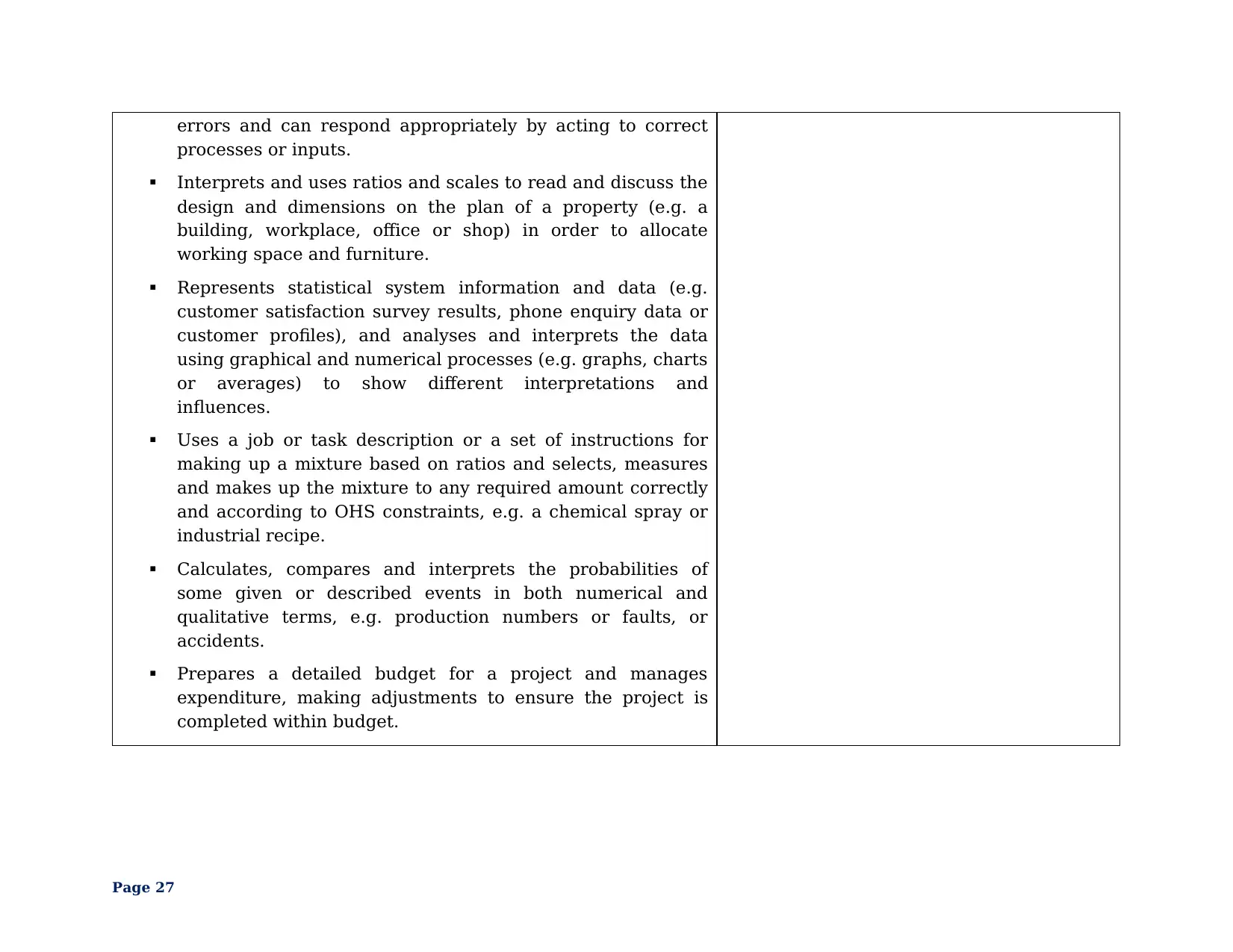
errors and can respond appropriately by acting to correct
processes or inputs.
Interprets and uses ratios and scales to read and discuss the
design and dimensions on the plan of a property (e.g. a
building, workplace, office or shop) in order to allocate
working space and furniture.
Represents statistical system information and data (e.g.
customer satisfaction survey results, phone enquiry data or
customer profiles), and analyses and interprets the data
using graphical and numerical processes (e.g. graphs, charts
or averages) to show different interpretations and
influences.
Uses a job or task description or a set of instructions for
making up a mixture based on ratios and selects, measures
and makes up the mixture to any required amount correctly
and according to OHS constraints, e.g. a chemical spray or
industrial recipe.
Calculates, compares and interprets the probabilities of
some given or described events in both numerical and
qualitative terms, e.g. production numbers or faults, or
accidents.
Prepares a detailed budget for a project and manages
expenditure, making adjustments to ensure the project is
completed within budget.
Page 27
processes or inputs.
Interprets and uses ratios and scales to read and discuss the
design and dimensions on the plan of a property (e.g. a
building, workplace, office or shop) in order to allocate
working space and furniture.
Represents statistical system information and data (e.g.
customer satisfaction survey results, phone enquiry data or
customer profiles), and analyses and interprets the data
using graphical and numerical processes (e.g. graphs, charts
or averages) to show different interpretations and
influences.
Uses a job or task description or a set of instructions for
making up a mixture based on ratios and selects, measures
and makes up the mixture to any required amount correctly
and according to OHS constraints, e.g. a chemical spray or
industrial recipe.
Calculates, compares and interprets the probabilities of
some given or described events in both numerical and
qualitative terms, e.g. production numbers or faults, or
accidents.
Prepares a detailed budget for a project and manages
expenditure, making adjustments to ensure the project is
completed within budget.
Page 27
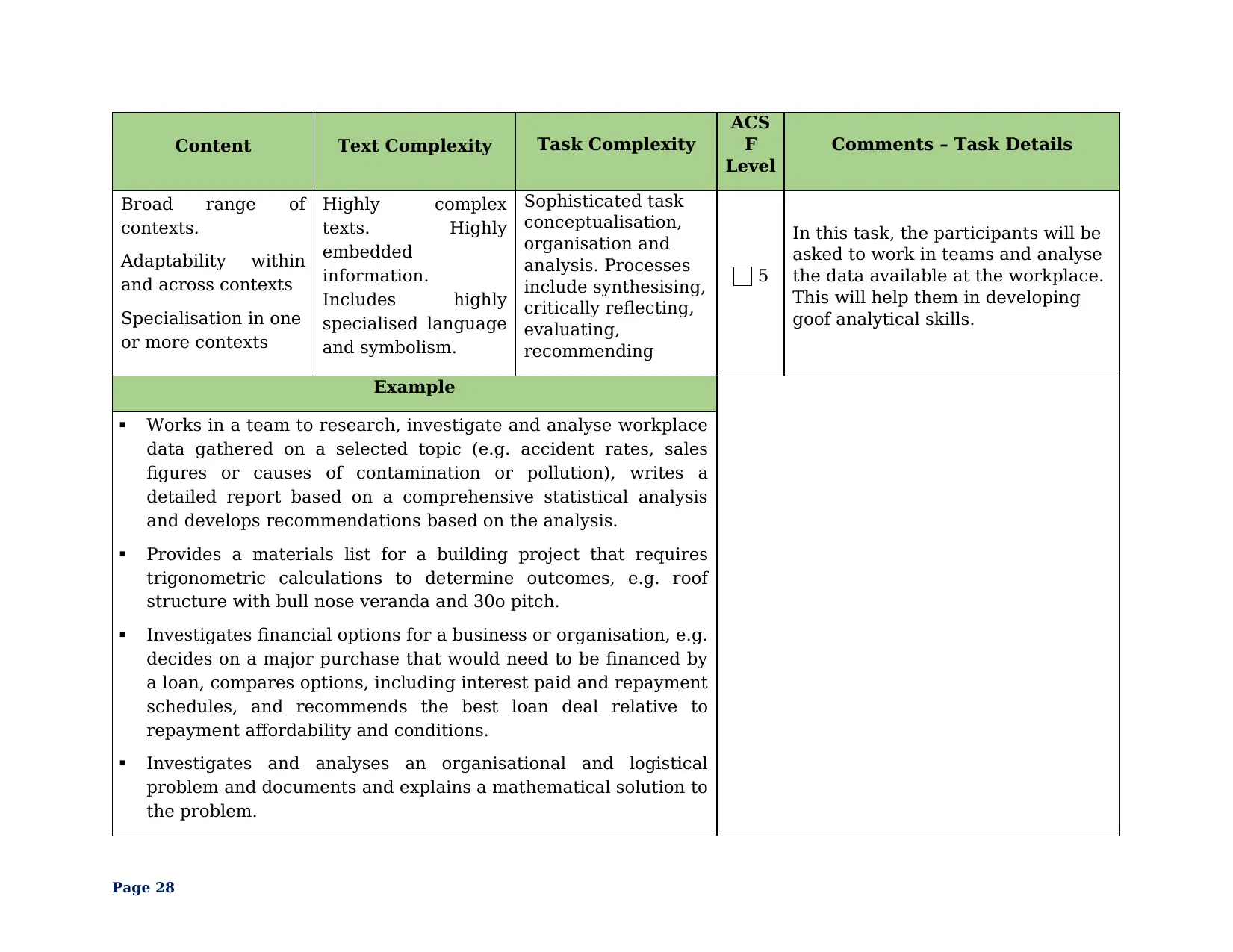
Content Text Complexity Task Complexity
ACS
F
Level
Comments – Task Details
Broad range of
contexts.
Adaptability within
and across contexts
Specialisation in one
or more contexts
Highly complex
texts. Highly
embedded
information.
Includes highly
specialised language
and symbolism.
Sophisticated task
conceptualisation,
organisation and
analysis. Processes
include synthesising,
critically reflecting,
evaluating,
recommending
5
In this task, the participants will be
asked to work in teams and analyse
the data available at the workplace.
This will help them in developing
goof analytical skills.
Example
Works in a team to research, investigate and analyse workplace
data gathered on a selected topic (e.g. accident rates, sales
figures or causes of contamination or pollution), writes a
detailed report based on a comprehensive statistical analysis
and develops recommendations based on the analysis.
Provides a materials list for a building project that requires
trigonometric calculations to determine outcomes, e.g. roof
structure with bull nose veranda and 30o pitch.
Investigates financial options for a business or organisation, e.g.
decides on a major purchase that would need to be financed by
a loan, compares options, including interest paid and repayment
schedules, and recommends the best loan deal relative to
repayment affordability and conditions.
Investigates and analyses an organisational and logistical
problem and documents and explains a mathematical solution to
the problem.
Page 28
ACS
F
Level
Comments – Task Details
Broad range of
contexts.
Adaptability within
and across contexts
Specialisation in one
or more contexts
Highly complex
texts. Highly
embedded
information.
Includes highly
specialised language
and symbolism.
Sophisticated task
conceptualisation,
organisation and
analysis. Processes
include synthesising,
critically reflecting,
evaluating,
recommending
5
In this task, the participants will be
asked to work in teams and analyse
the data available at the workplace.
This will help them in developing
goof analytical skills.
Example
Works in a team to research, investigate and analyse workplace
data gathered on a selected topic (e.g. accident rates, sales
figures or causes of contamination or pollution), writes a
detailed report based on a comprehensive statistical analysis
and develops recommendations based on the analysis.
Provides a materials list for a building project that requires
trigonometric calculations to determine outcomes, e.g. roof
structure with bull nose veranda and 30o pitch.
Investigates financial options for a business or organisation, e.g.
decides on a major purchase that would need to be financed by
a loan, compares options, including interest paid and repayment
schedules, and recommends the best loan deal relative to
repayment affordability and conditions.
Investigates and analyses an organisational and logistical
problem and documents and explains a mathematical solution to
the problem.
Page 28
Secure Best Marks with AI Grader
Need help grading? Try our AI Grader for instant feedback on your assignments.

Page 29
1 out of 29
Your All-in-One AI-Powered Toolkit for Academic Success.
+13062052269
info@desklib.com
Available 24*7 on WhatsApp / Email
![[object Object]](/_next/static/media/star-bottom.7253800d.svg)
Unlock your academic potential
© 2024 | Zucol Services PVT LTD | All rights reserved.



